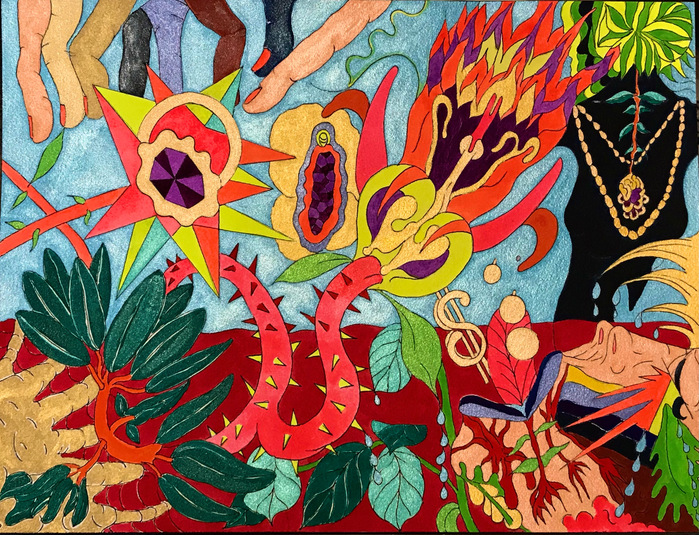
The Family Jeweler, 2022, acrylic ink on paper
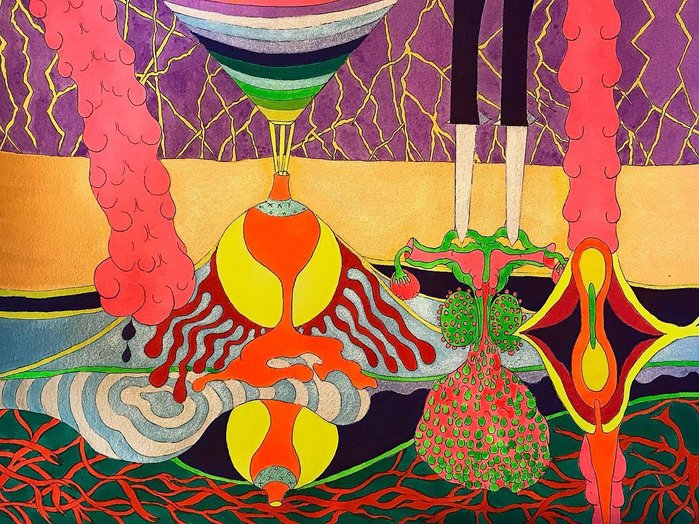
What Planet Am I On? #3, acrylic ink on paper
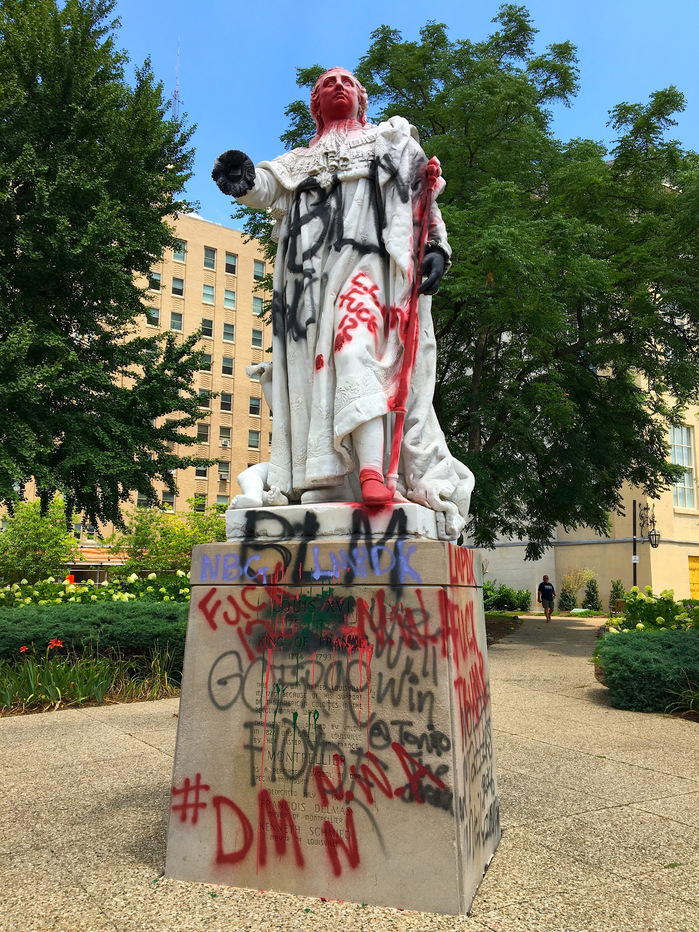
Statue of Louis XVI, Louisville, KY, 2020. Photo by Maiza Hixson.
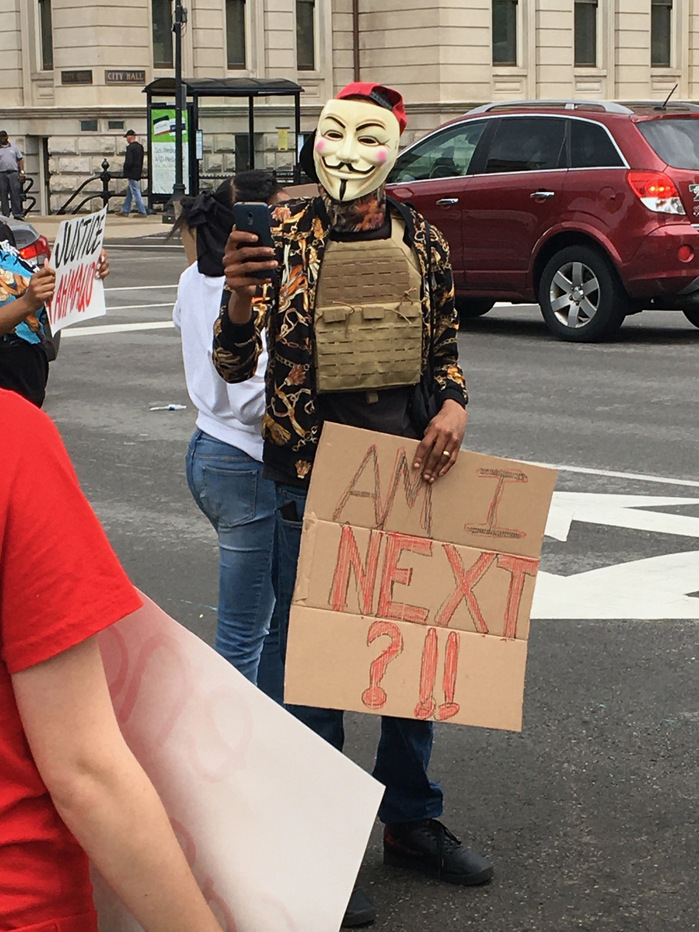
Louisville, 2020.
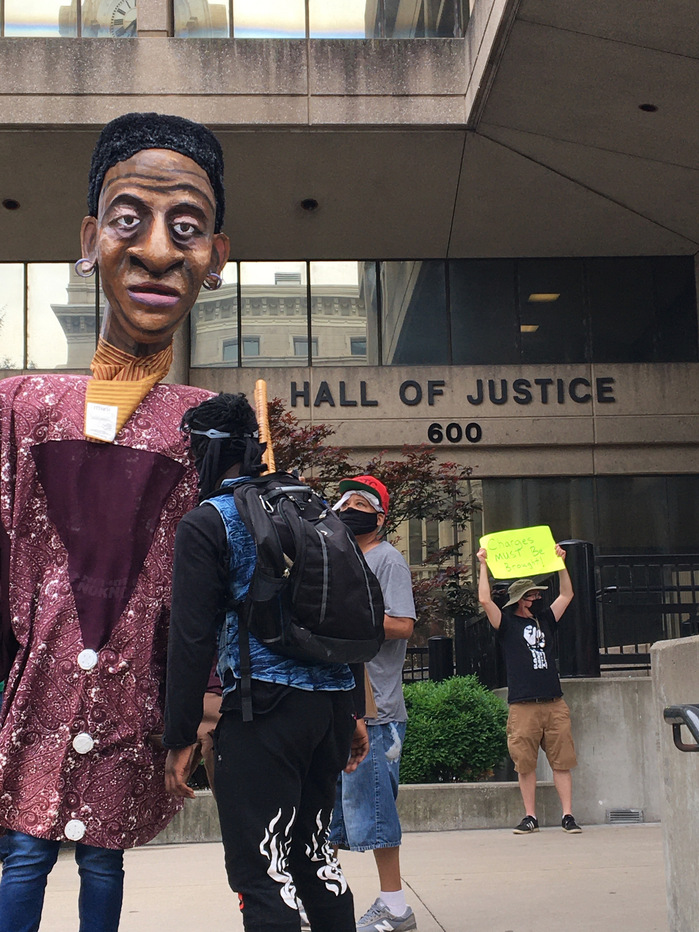
Louisville Hall of Justice, 2020.
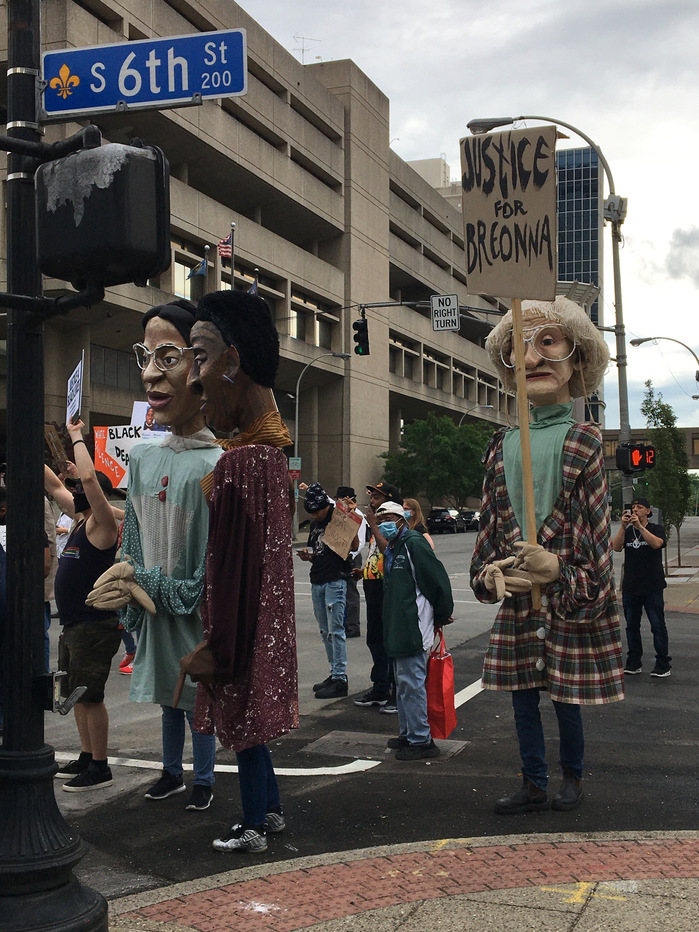
Louisville, 6th & Jefferson, 2020.
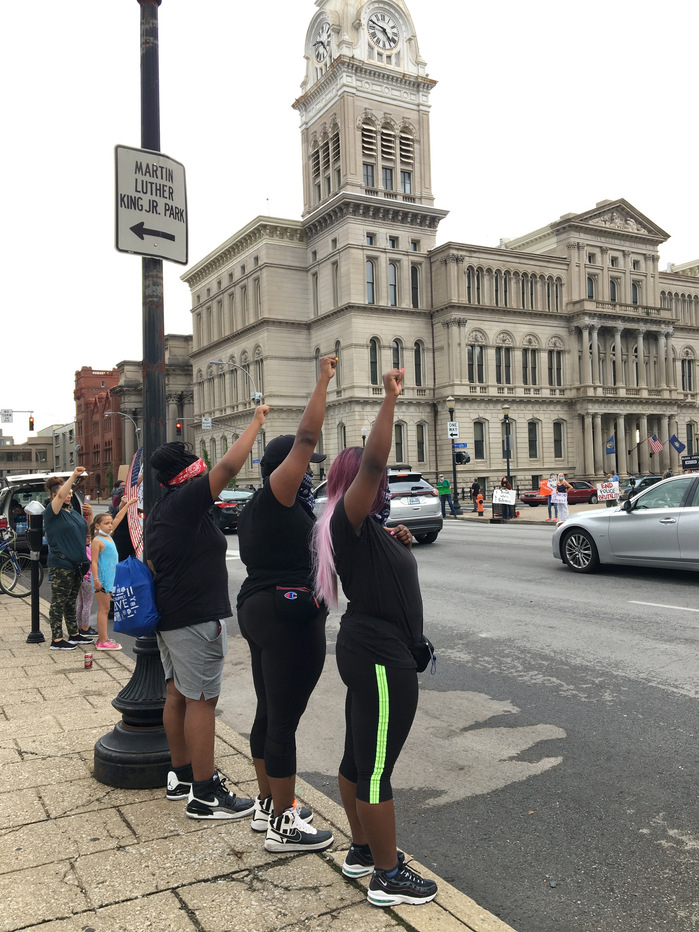
Louisville, Injustice Square, City Hall, 2020.
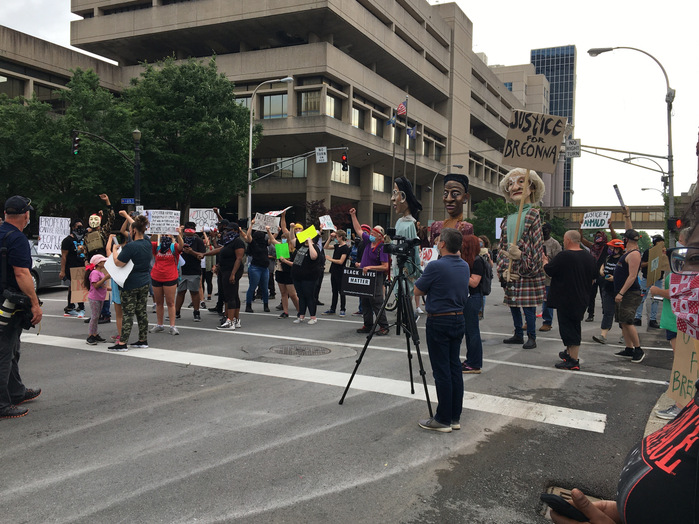
Louisville, 2020.

Not Fucking Around Coalition, Louisville, 2020.
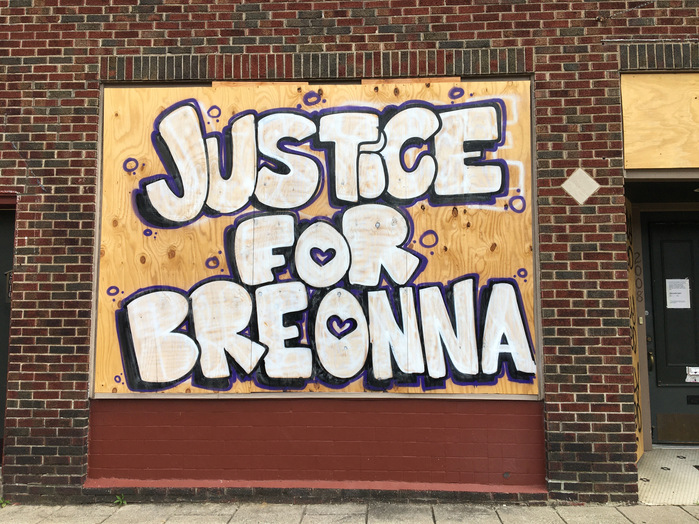
Louisville, KY, 2020.
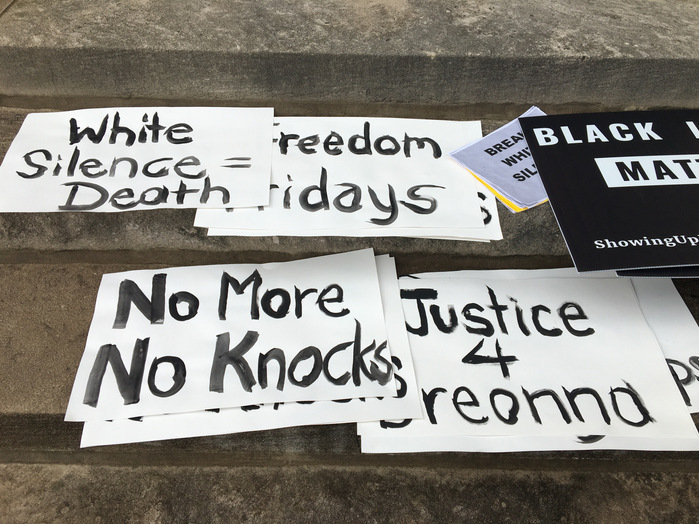
Louisville, 2020.
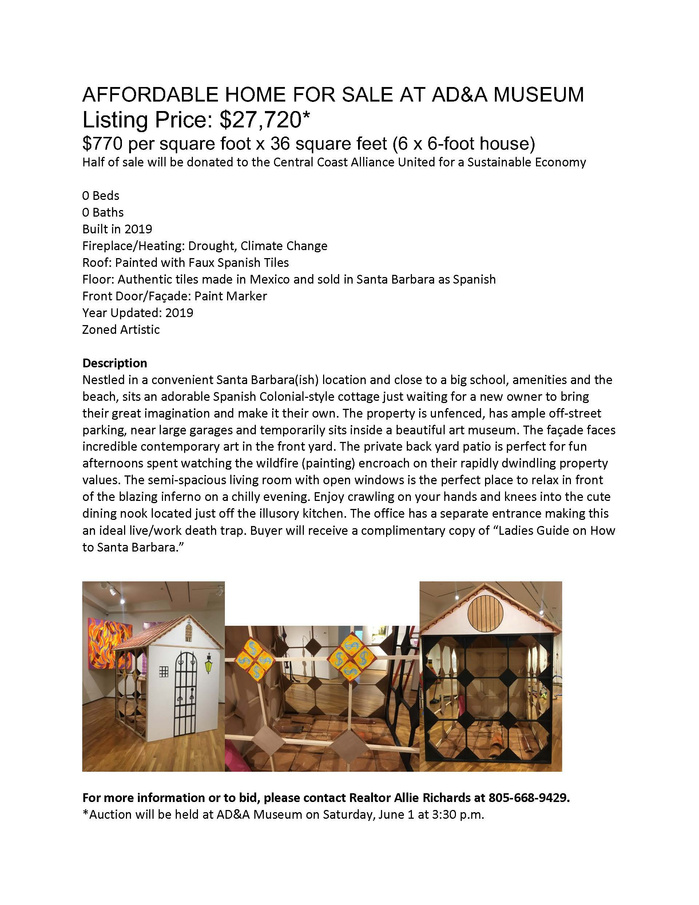
Maiza Hixson, How to San Losiento (Mi Casita Es Su Casita), 2019, Affordable Housing price listing
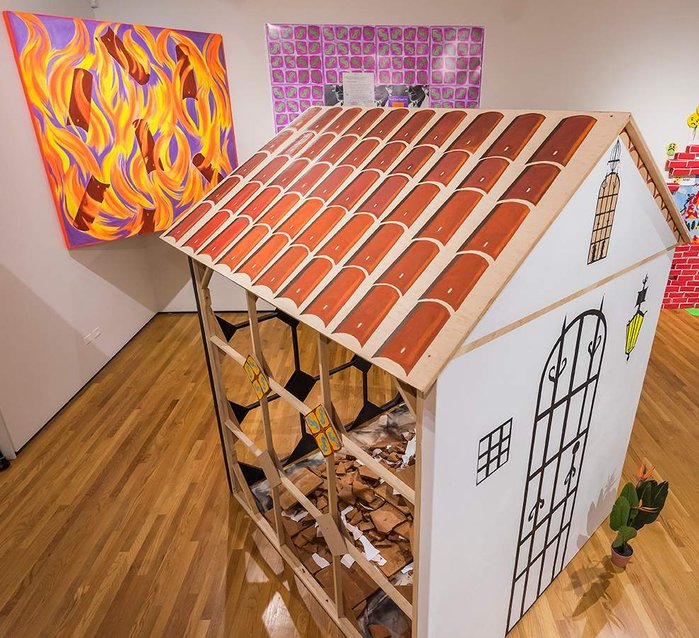
Maiza Hixson, Installation at the Art, Design and Architecture Museum, University of California Santa Barbara; How to San Losiento (Mi Casita Es Su Casita), 2019
Paintings: Roof(Diptych), Facade, $panish Colonial Tiles, Charred, Fire/birds of Paradise
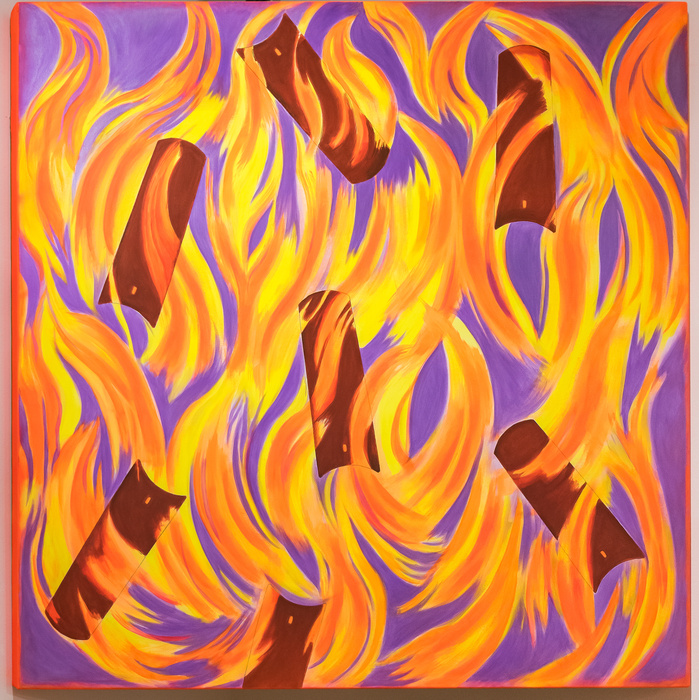
Maiza Hixson,
Fire/birds of Paradise, 2019
Graphite, acrylic ink and micron pen on canvas on Spanish Colonial roof tiles
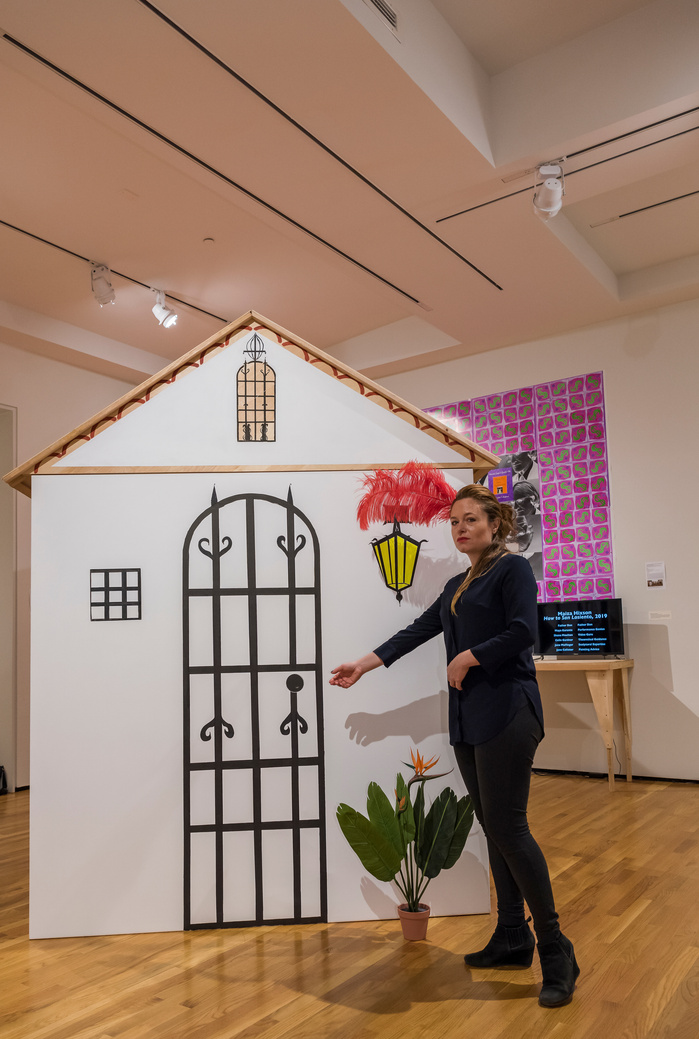
Maiza Hixson, How to San Losiento (Mi Casita Es Su Casita), 2019
Paintings: Roof (Diptych), Facade, $panish Colonial Tiles, Charred, Fire/birds of Paradise; play, performance, archive
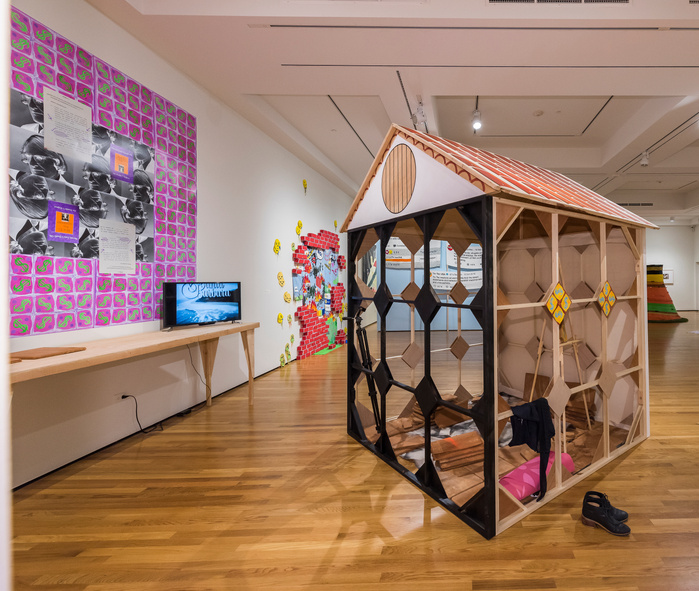
Maiza Hixson, How to San Losiento (Mi Casita Es Su Casita), 2019
Paintings: Roof (Diptych), Facade, $panish Colonial Tiles, Charred, Fire/birds of Paradise; play, performance, archive
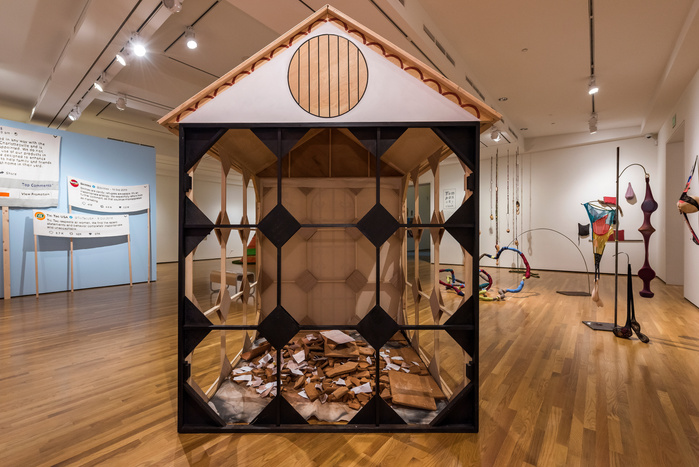
Maiza Hixson, How to San Losiento (Mi Casita Es Su Casita), 2019, Paintings: Roof(Diptych), Facade, $panish Colonial Tiles, Charred
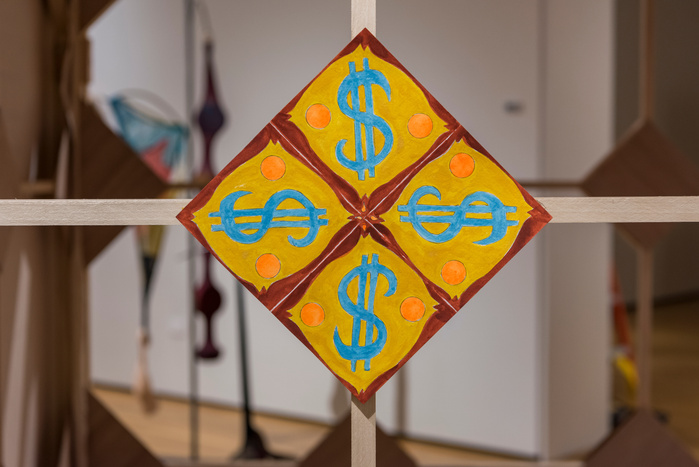
Maiza Hixson, How to San Losiento (Mi Casita Es Su Casita), $panish Colonial Tile, painting, 2019
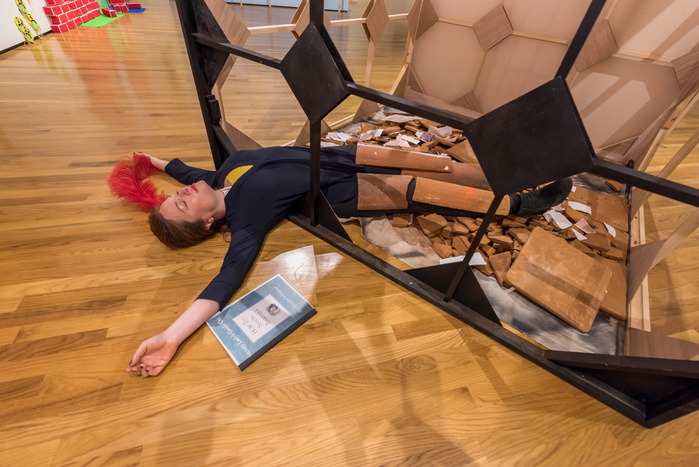
Maiza Hixson, How to San Losiento (Mi Casita Es Su Casita), 2019
$panish Colonial Tiles performance, artist book
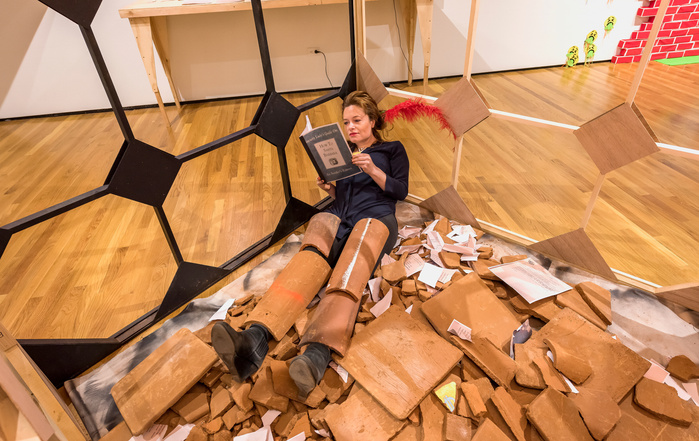
Maiza Hixson, How to San Losiento (Mi Casita Es Su Casita), 2019
$panish Colonial Tiles performance, artist book
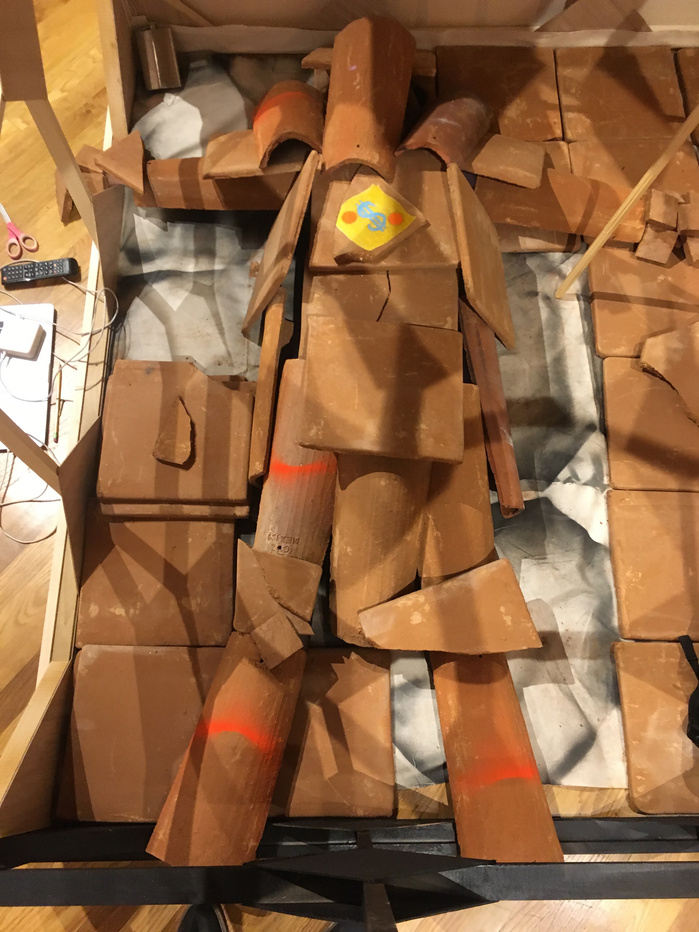
Maiza Hixson, How to San Losiento (Mi Casita Es Su Casita), 2019, $panish Colonial Tile performance
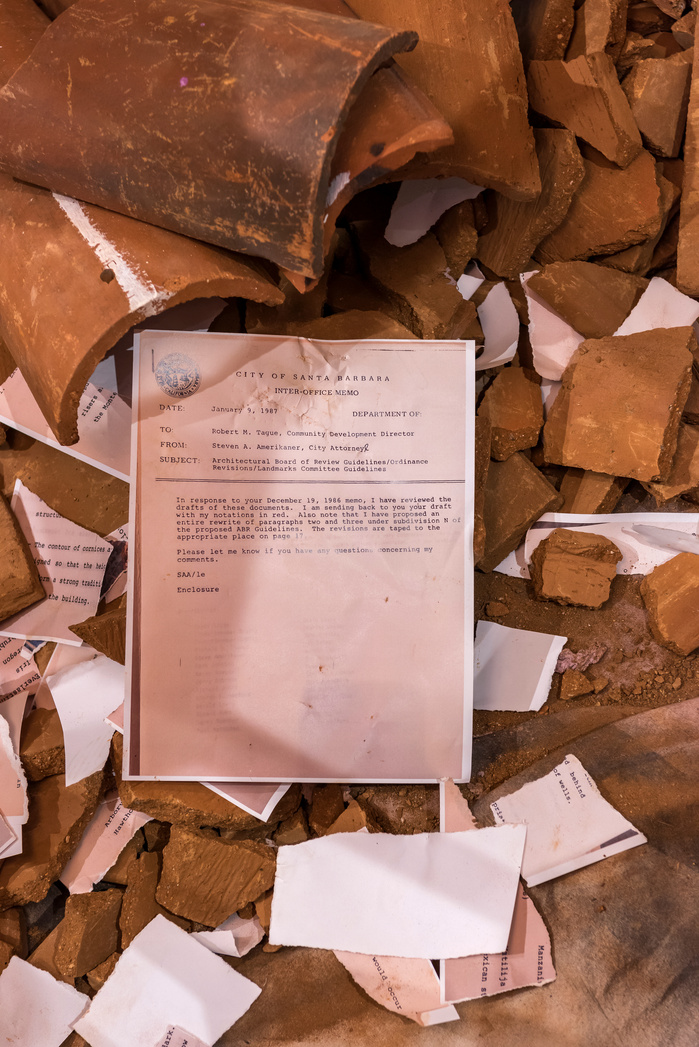
Maiza Hixson, How to San Losiento (Mi Casita Es Su Casita), 2019, David Gebhard archival papers, Spanish Colonial Tiles made in Mexico, sold in Santa Barbara (rubble)
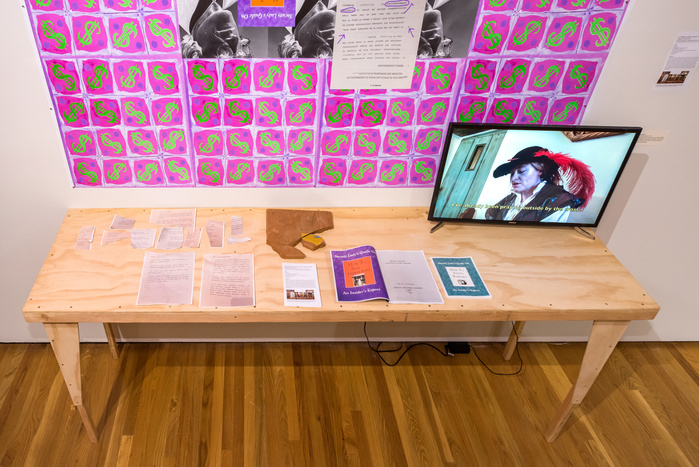
Maiza Hixson, How to San Losiento (Mi Casita Es Su Casita), 2019, Spanish Colonial Tiles made in Mexico, sold in Santa Barbara, David Gebhard archival papers, artist book, digital video, performance, digital print
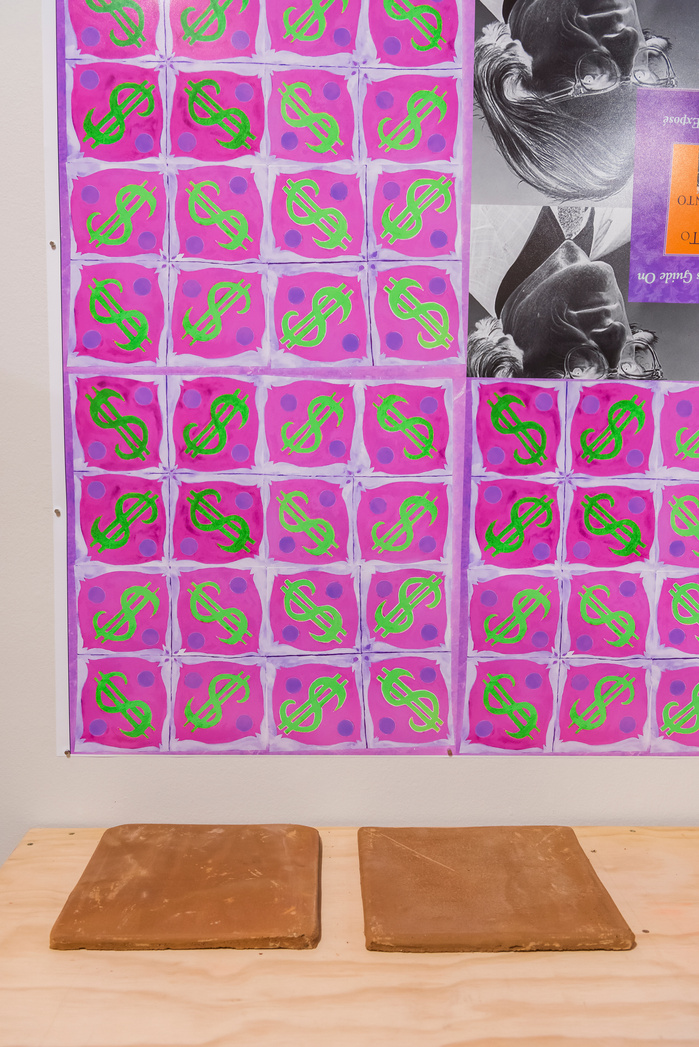
Maiza Hixson, How to San Losiento (Mi Casita Es Su Casita), 2019, Spanish Colonial Tiles made in Mexico, sold in Santa Barbara, archive, digital print
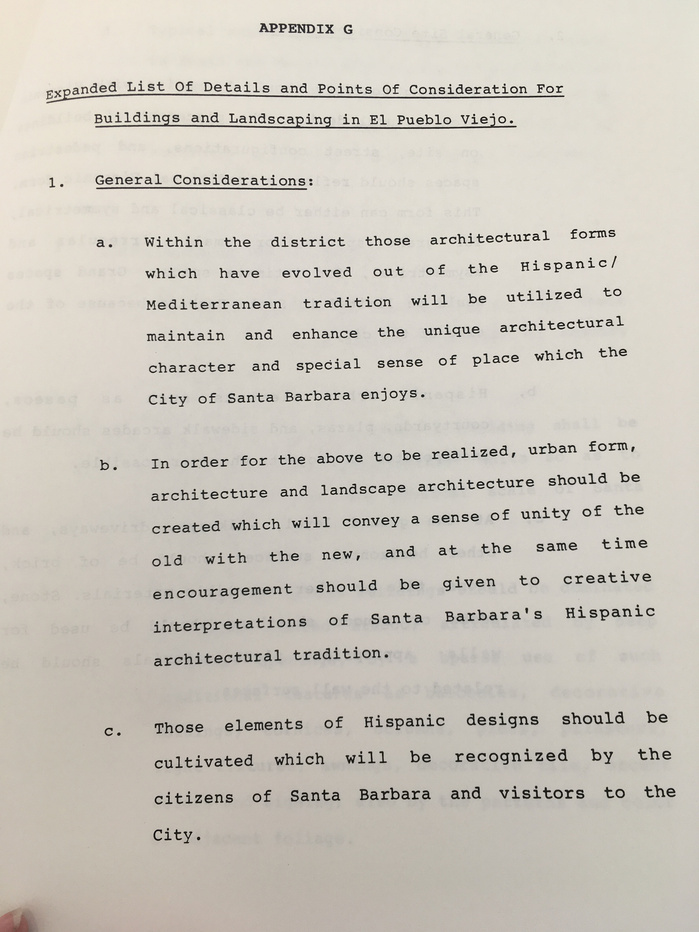
Maiza Hixson, How to San Losiento (Mi Casita Es Su Casita), 2019, David Gebhard Archive, Collection of the Art, Design and Architecture Museum, UC Santa Barbara
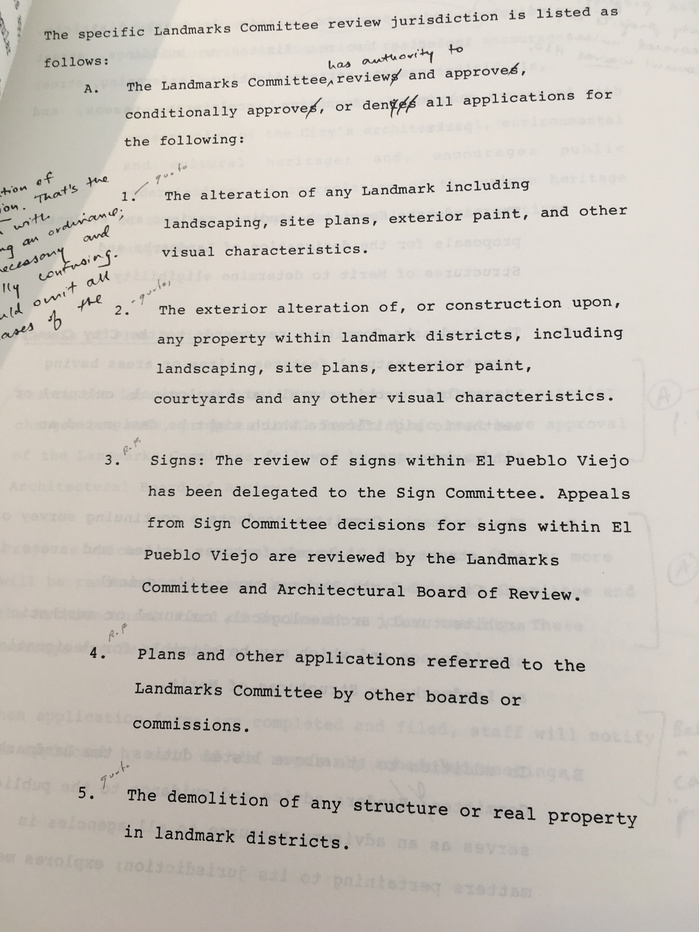
Maiza Hixson, How to San Losiento (Mi Casita Es Su Casita), 2019, David Gebhard Archive, Collection of the Art, Design and Architecture Museum, UC Santa Barbara
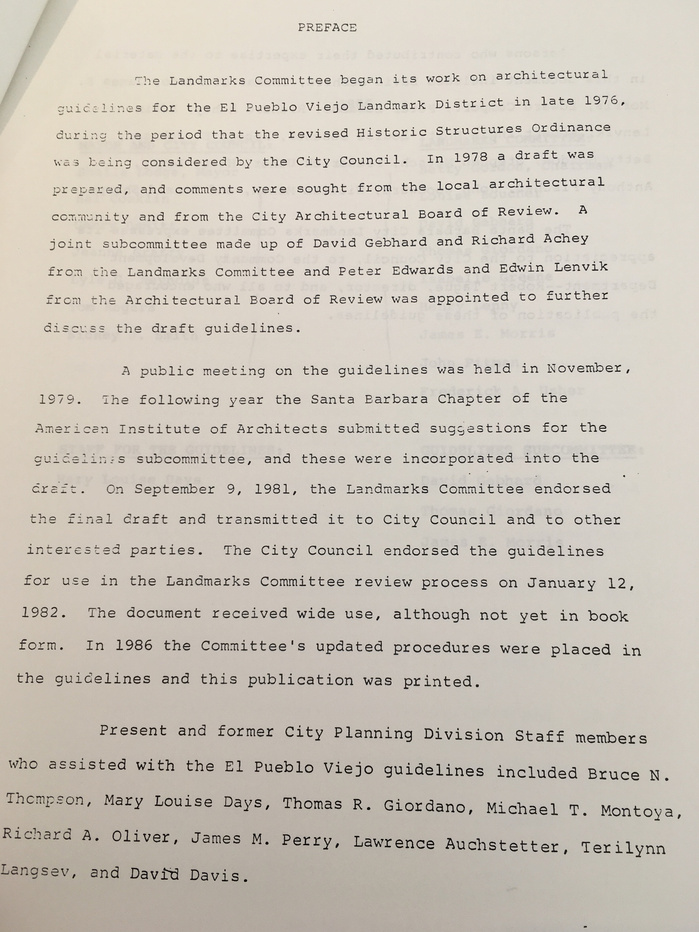
Maiza Hixson, How to San Losiento (Mi Casita Es Su Casita), 2019, David Gebhard Archive, Collection of the Art, Design and Architecture Museum, UC Santa Barbara
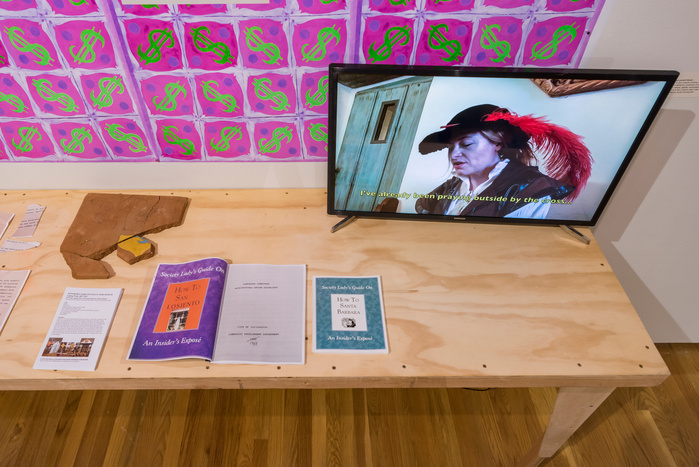
Maiza Hixson, How to San Losiento (Mi Casita Es Su Casita), 2019, Spanish Colonial Tiles made in Mexico, sold in Santa Barbara, archive, artist book, digital video, performance, digital print
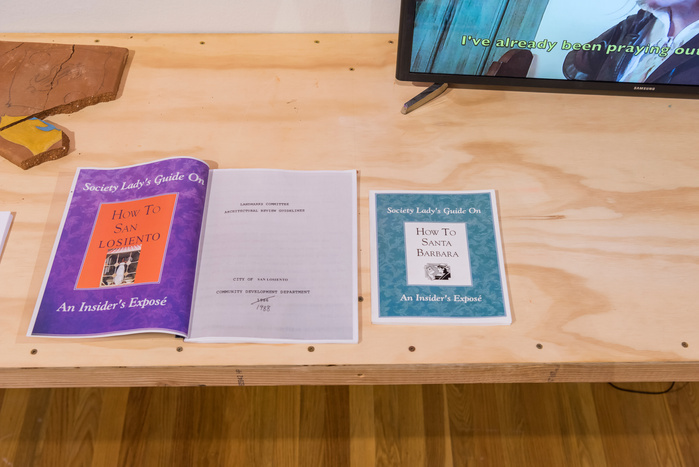
Maiza Hixson, How to San Losiento (Mi Casita Es Su Casita), 2019, Spanish Colonial Tiles made in Mexico, sold in Santa Barbara, archive, artist book, digital video, performance
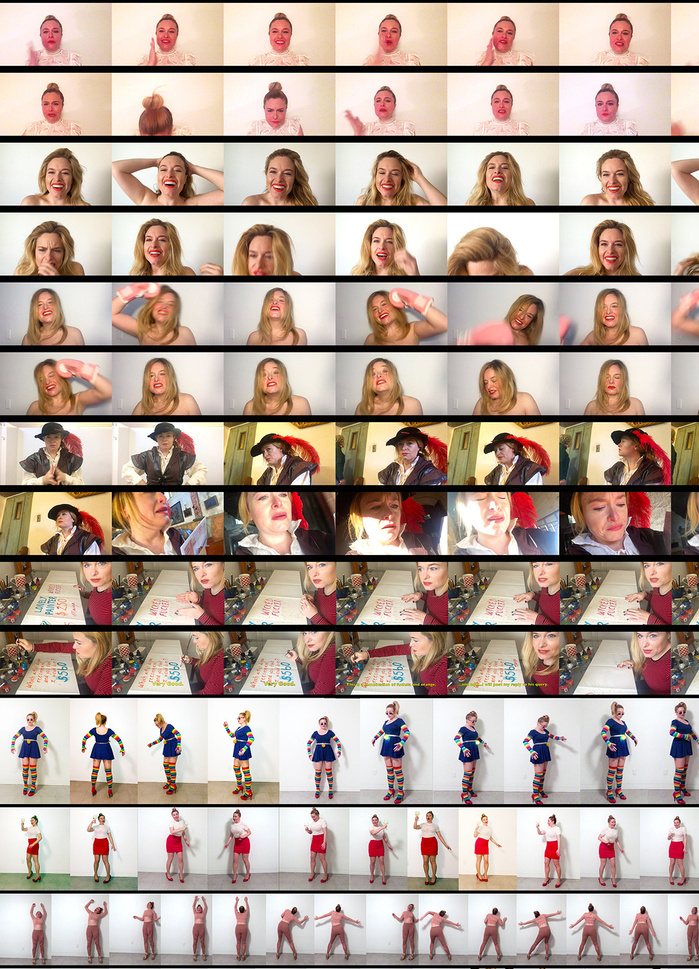
Maiza Hixson, Protean Features, 2018, digital video stills from select performances, 2017-2018
Maiza Hixson, 2018, The Mission: A Santa Barbara Odyssey, digital video performance directed and performed by Maiza Hixson, with Juan Silverio and Father Dan.
Mayoral Campaign Speech (Abridged version), 2017, Santa Barbara Center for Art, Science and Technology.
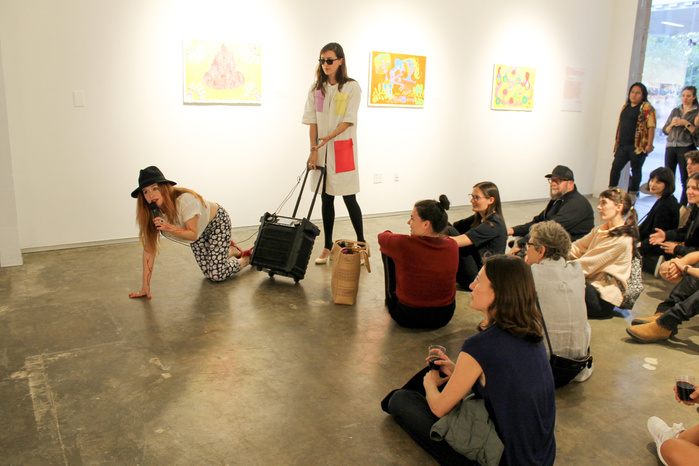
Maiza Hixson, Internet's Down, exhibition and curatorial tour on my knees, assisted by Madeleine Eve Ignon, Glassbox Gallery, UC Santa Barbara, 2018, photo by Debra Herrick.
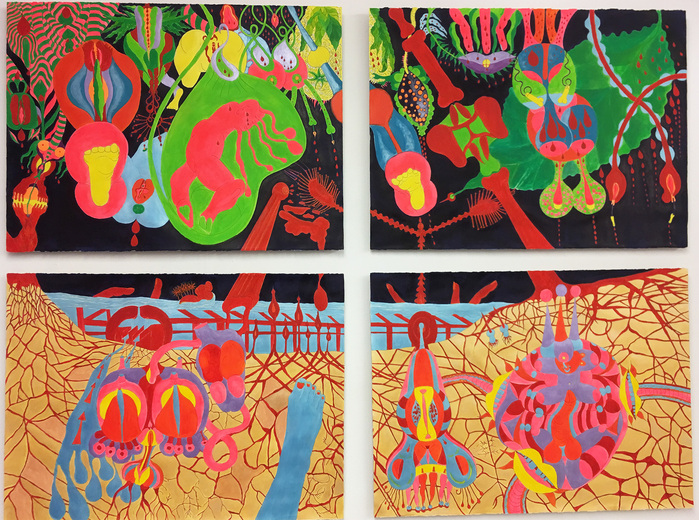
Maiza Hixson, 2018, Phantom Fibroids Everywhere, graphite and acrylic ink on paper
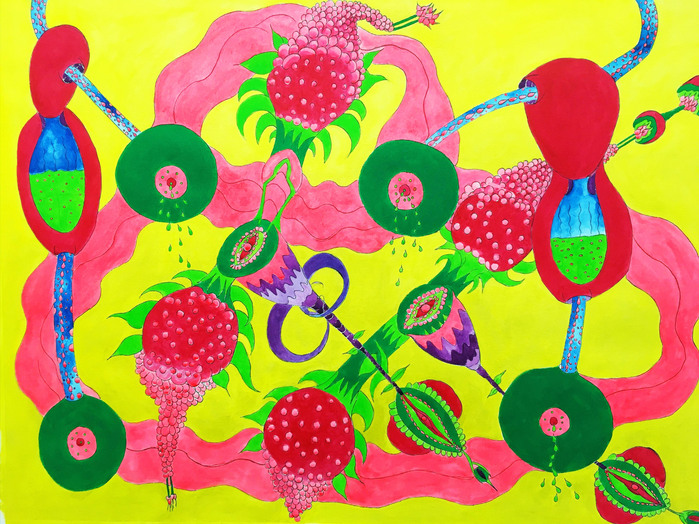
Maiza Hixson, 2018, Sustainable Futures, graphite and acrylic ink on paper, Collection of Dr. Jennifer Sorkin
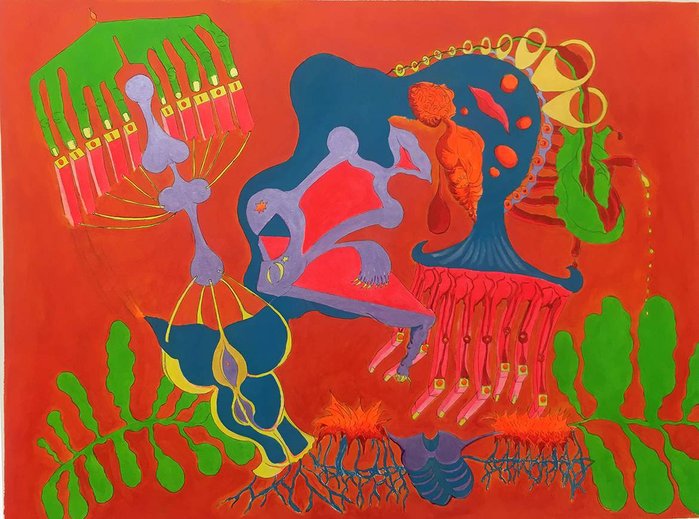
Maiza Hixson, 2018, Green Heart (It'll Grow Back Someday, Maybe), graphite and acrylic ink on paper
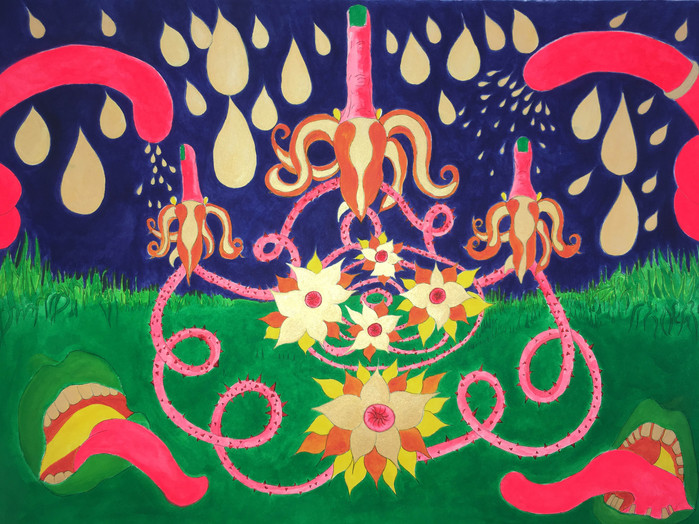
Maiza Hixson, 2018, The Long Drought (There's a Good Lookin' Rain/Man in Your Future), 2018, ink on paper
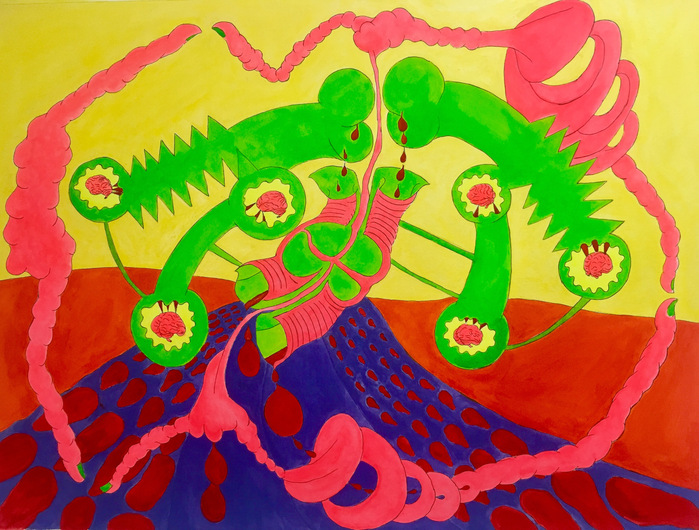
Maiza Hixson, 2018, We Have The Power, graphite and acrylic ink on paper
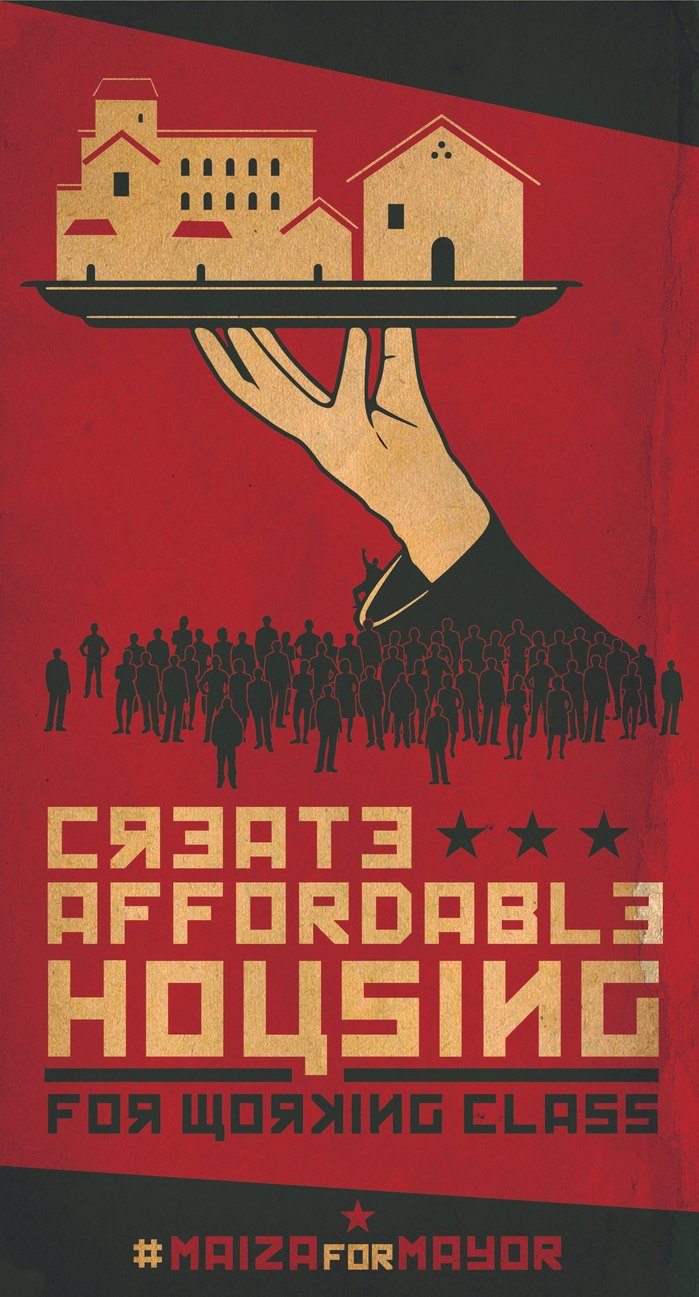
Maiza For Mayor Campaign Poster for Affordable Housing, 2017, designed by Joe Beraldo.
Mayoral Statement by Maiza Hixson, 2017:

Disobedient Artists Party, 2017, socially-engaged project and campaign for Art Mayor of Santa Barbara, wooden token design by Joe Beraldo.
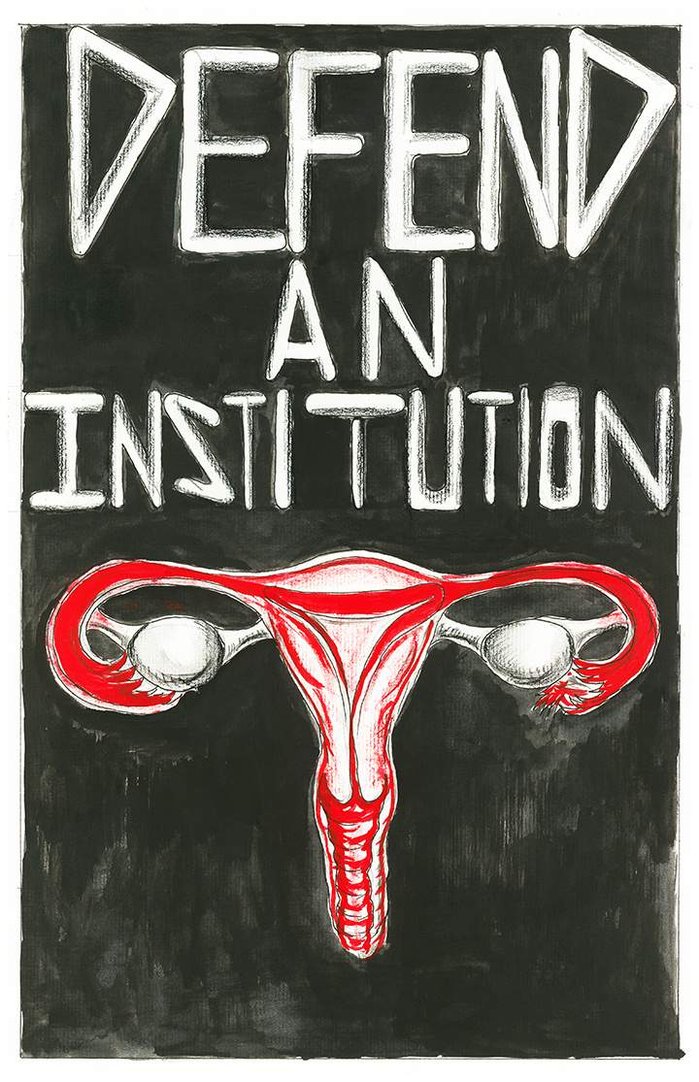
Defend An Institution, 2018, poster illustrating one of historian Timothy Snyder's Twenty Ways to Defend Democracy, proceeds from poster sale donated to the American Civil Liberties Union.
By Maiza Hixson
In Defense of Democracy features twenty artists who employ the poster as a political medium, to agitate and create resistance against the reactionary forces threatening American civil rights. Approaching art from an activist standpoint, my fellow co-curator and artist Lucy Holtsnider invited select participants to illustrate one of acclaimed historian Timothy Snyder’s Twenty Ways to Defend Democracy. A scholar who has studied the foundations of Nazi Germany, Snyder’s recent book On Tyranny: Twenty Lessons From the 20th Century is a cautionary rubric for thwarting fascism in America and the impetus behind this exhibition.
Throughout the past century, visual artists have designed iconic popular imagery for economic, racial and social justice movements. In the 1930s, Hungarian-American muralist Hugo Gellert designed lithographs for the Communist party and covers for the Daily Worker magazine, which championed labor rights for all, from the coalmines to the factory floor. Taking visual cues from modernist Russian Constructivist art and the photomontages of the Bauhaus, another leftist paper entitled Labor Defender also galvanized progressive groups around equality.
The most well known artist of the Black Panther movement, Emory Douglas, designed posters that borrowed styles and techniques from German artists like John Heartfield and George Grosz as well as Mexican artists like Jose Guadalupe Posada and Elizabeth Catlett.[1]
Canonical feminist groups such as the Guerilla Girls and Riot Grrrls have designed posters, flyers and zines that indict and critique male-dominated culture and confining gender roles for women. Kathleen Hanna, synonymous with feminist punk bands Bikini Kill and Le Tigre, was a punk zine writer and pioneer of the Riot Grrrls. In response to the movement as primarily white and middle class, women of color like Mimi Thi Nguyen designed zines that critiqued white supremacy within punk music culture.[2]
With President Donald J. Trump’s proposed budgetary cuts to the National Institute of Health, Environmental Protection Agency and National Endowment for the Arts, artists, activists and people of all backgrounds across the United States have taken up pen and paintbrush to create protest signage. Famously, on the night before the D.C. Women’s March of January 21, 2017, stores such as Office Depot, Staples and Target were completely sold out of poster board, forcing some protestors to make signs out of moving boxes and other materials.[3]
Making political protest signage provides a productive channel and release valve for frustrated citizens to voice their dissent. As an exhibition, In Defense of Democracy seeks to employ anti-fascist posters as an educational tool to motivate viewers to counteract oppression by understanding the specious language, branding and manipulation promulgated by Trump’s ministers of culture and propaganda.
Underlying the political dissent implicit in each of the artists’ works on view in the exhibition is the concept that In Defense of Democracy serves to decry the ascendance of authoritarian regimes, both at home and abroad.
Read Snyder’s lessons from his latest book On Tyranny: Twenty Lessons from the Twentieth Century:
1. Do not obey in advance. Much of the power of authoritarianism is freely given. In times like these, individuals think ahead about what a more repressive government will want, and then start to do it without being asked. You’ve already done this, haven’t you? Stop. Anticipatory obedience teaches authorities what is possible and accelerates unfreedom.
2. Defend an institution. Follow the courts or the media, or a court or a newspaper. Do not speak of “our institutions” unless you are making them yours by acting on their behalf. Institutions don’t protect themselves. They go down like dominoes unless each is defended from the beginning.
3. Recall professional ethics. When the leaders of state set a negative example, professional commitments to just practice become much more important. It is hard to break a rule-of-law state without lawyers, and it is hard to have show trials without judges.
4. When listening to politicians, distinguish certain words. Look out for the expansive use of “terrorism” and “extremism.” Be alive to the fatal notions of “exception” and “emergency.” Be angry about the treacherous use of patriotic vocabulary.
5. Be calm when the unthinkable arrives. When the terrorist attack comes, remember that all authoritarians at all times either await or plan such events in order to consolidate power. Think of the Reichstag fire. The sudden disaster that requires the end of the balance of power, the end of opposition parties, and so on, is the oldest trick in the Hitlerian book. Don’t fall for it.
6. Be kind to our language. Avoid pronouncing the phrases everyone else does. Think up your own way of speaking, even if only to convey that thing you think everyone is saying. (Don’t use the internet before bed. Charge your gadgets away from your bedroom, and read.) What to read? Perhaps “The Power of the Powerless” by Václav Havel, 1984 by George Orwell, The Captive Mind by Czesław Milosz, The Rebel by Albert Camus, The Origins of Totalitarianism by Hannah Arendt, or Nothing is True and Everything is Possible by Peter Pomerantsev.
7. Stand out. Someone has to. It is easy, in words and deeds, to follow along. It can feel strange to do or say something different. But without that unease, there is no freedom. And the moment you set an example, the spell of the status quo is broken, and others will follow.
8. Believe in truth. To abandon facts is to abandon freedom. If nothing is true, then no one can criticize power, because there is no basis upon which to do so. If nothing is true, then all is spectacle. The biggest wallet pays for the most blinding lights.
9. Investigate. Figure things out for yourself. Spend more time with long articles. Subsidize investigative journalism by subscribing to print media. Realize that some of what is on your screen is there to harm you. Learn about sites that investigate foreign propaganda pushes.
10. Practice corporeal politics. Power wants your body softening in your chair and your emotions dissipating on the screen. Get outside. Put your body in unfamiliar places with unfamiliar people. Make new friends and march with them.
11. Make eye contact and small talk. This is not just polite. It is a way to stay in touch with your surroundings, break down unnecessary social barriers, and come to understand whom you should and should not trust. If we enter a culture of denunciation, you will want to know the psychological landscape of your daily life.
12. Take responsibility for the face of the world. Notice the swastikas and the other signs of hate. Do not look away and do not get used to them. Remove them yourself and set an example for others to do so.
13. Hinder the one-party state. The parties that took over states were once something else. They exploited a historical moment to make political life impossible for their rivals. Vote in local and state elections while you can.
14. Give regularly to good causes, if you can. Pick a charity and set up autopay. Then you will know that you have made a free choice that is supporting civil society helping others doing something good.
15. Establish a private life. Nastier rulers will use what they know about you to push you around. Scrub your computer of malware. Remember that email is skywriting. Consider using alternative forms of the internet, or simply using it less. Have personal exchanges in person. For the same reason, resolve any legal trouble. Authoritarianism works as a blackmail state, looking for the hook on which to hang you. Try not to have too many hooks.
16. Learn from others in other countries. Keep up your friendships abroad, or make new friends abroad. The present difficulties here are an element of a general trend. And no country is going to find a solution by itself. Make sure you and your family have passports.
17. Watch out for the paramilitaries. When the men with guns who have always claimed to be against the system start wearing uniforms and marching around with torches and pictures of a Leader, the end is nigh. When the pro-Leader paramilitary and the official police and military intermingle, the game is over.
18. Be reflective if you must be armed. If you carry a weapon in public service, God bless you and keep you. But know that evils of the past involved policemen and soldiers finding themselves, one day, doing irregular things. Be ready to say no. (If you do not know what this means, contact the United States Holocaust Memorial Museum and ask about training in professional ethics.)
19. Be as courageous as you can. If none of us is prepared to die for freedom, then all of us will die in unfreedom.
20. Be a patriot. The incoming president is not. Set a good example of what America means for the generations to come. They will need it.
[1] Martha Schwendener, The New York Times, Seeing the Power of Political Posters, July 30, 2015, https://www.nytimes.com/2015/07/31/arts/design/seeing-the-power-of-political-posters.html
[2] Olivia Laing, The Guardian, The Art and Politics of Riot Grrrl in Pictures, June 29, 2013, https://www.theguardian.com/music/gallery/2013/jun/30/punk-music
[3] Madison Park, CNN News, Looking for poster boards? DC shelves empty as women's march nears, January 20, 2017, http://www.cnn.com/2017/01/20/politics/womens-march-supplies-trnd/
President-Elect Mr. Van's Televised Press Conference, 2017, in which I perform as Shellyanne von Einveg, Counselor to the President, Santa Barbara Center for Art, Science and Technology.
Maiza Hixson and Lauren Ruth (The Shaft), Dream Disaster, 2016-2017, post-apocalyptic performance and installation at the Santa Barbara Center for Art, Science and Technology, Santa Barbara, CA.
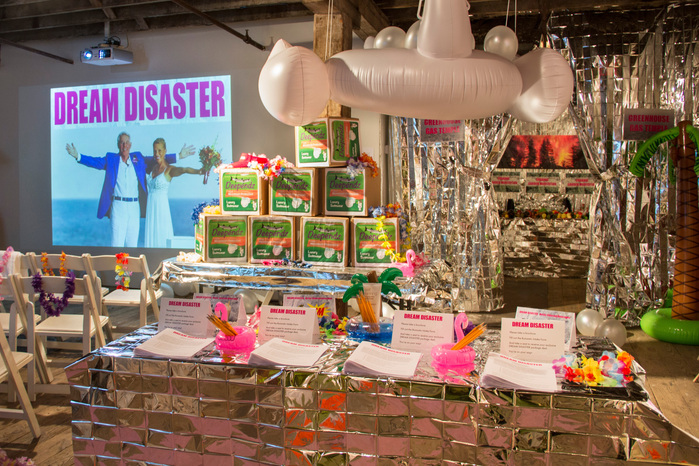
Maiza Hixson and Lauren Ruth (The Shaft), Dream Disaster: Romantic Paperwork and Intake Station, 2016-2017, post-apocalyptic performance and installation at Soap Factory, Minneapolis, MN
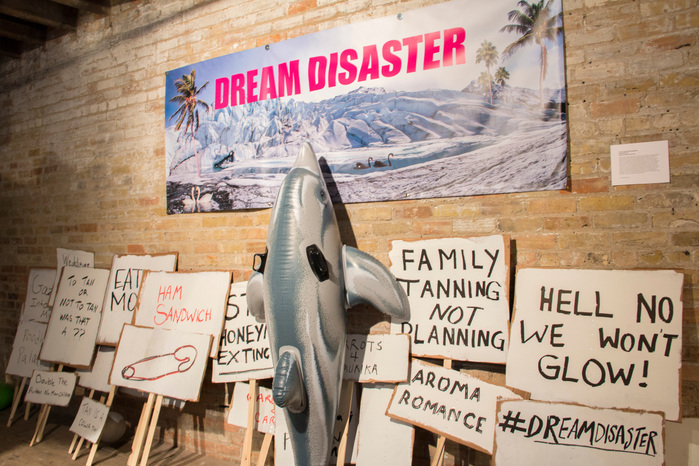
Maiza Hixson and Lauren Ruth (The Shaft), Dream Disaster: Tanning Bed Protests, 2016-2017, post-apocalyptic performance and installation at Soap Factory, Minneapolis, MN
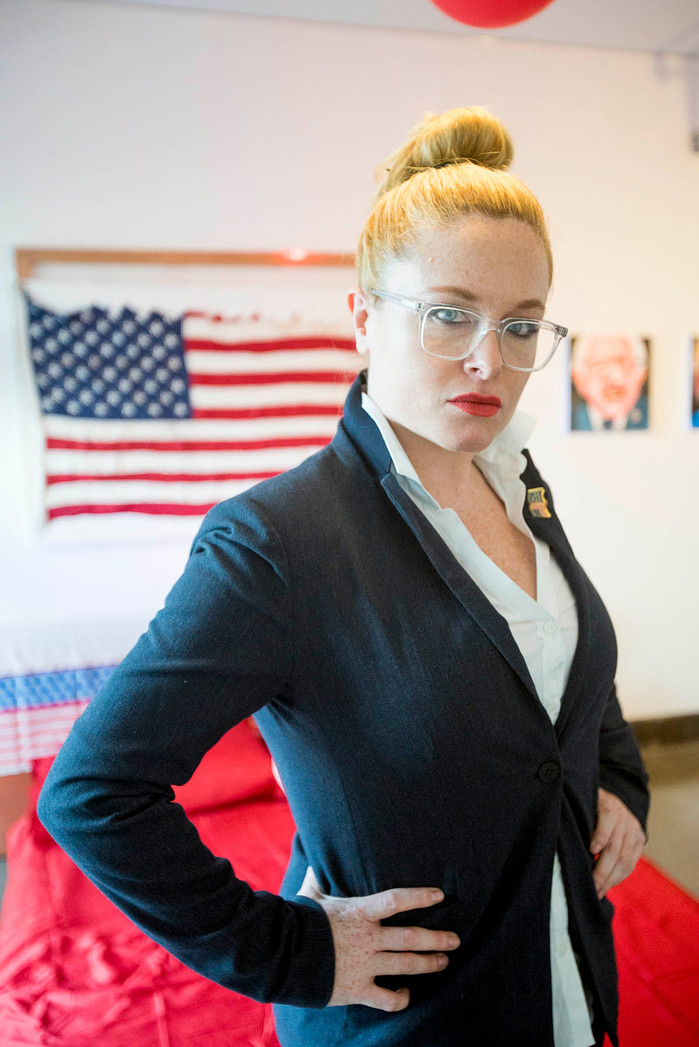
Running For Office, 2016, Santa Barbara Center for Art, Science and Technology, performing as Simon Pure, I ran for office on a platform of Radical Relaxation in which I delivered a stump speech and staged a disarmament protest from bed, featuring a five hour durational cuddling session with visitors
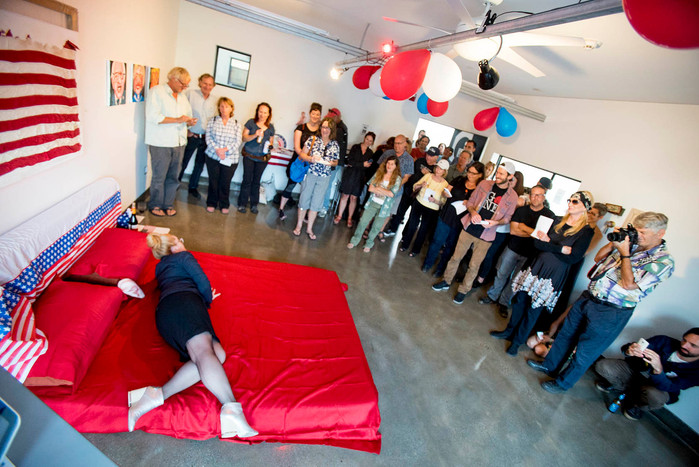
Running For Office, 2016, Santa Barbara Center for Art, Science and Technology, performing as Simon Pure, I ran for office on a platform of Radical Relaxation in which I delivered a stump speech and staged a disarmament protest from bed, featuring a five hour durational cuddling session with visitors
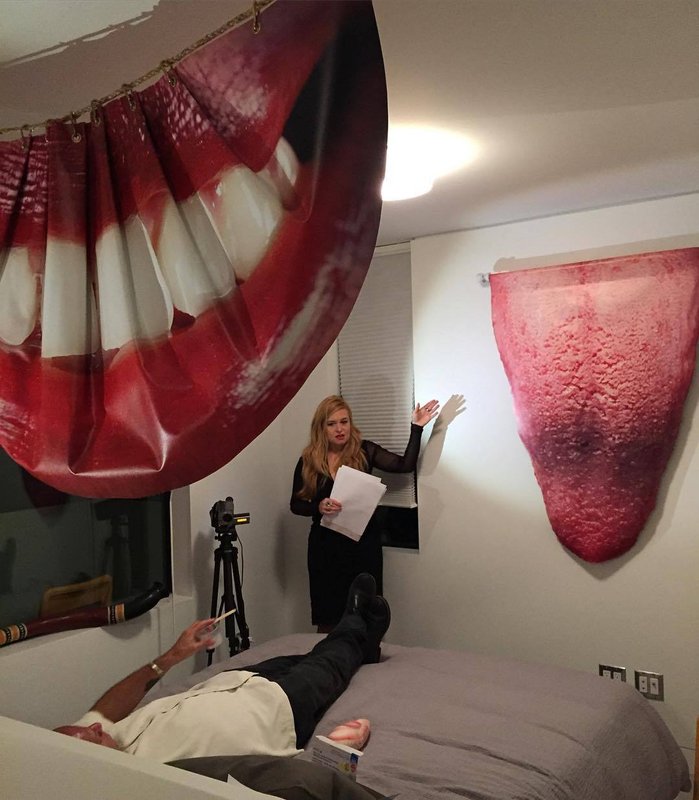
Chance Encounters, 2016, curatorial performance in which I interviewed participants on the oral histories of their tongues, inspired by the art of Lauren Ruth and Peter Schenck (not pictured), Santa Barbara Center for Art, Science and Technology, Santa Barbara, CA
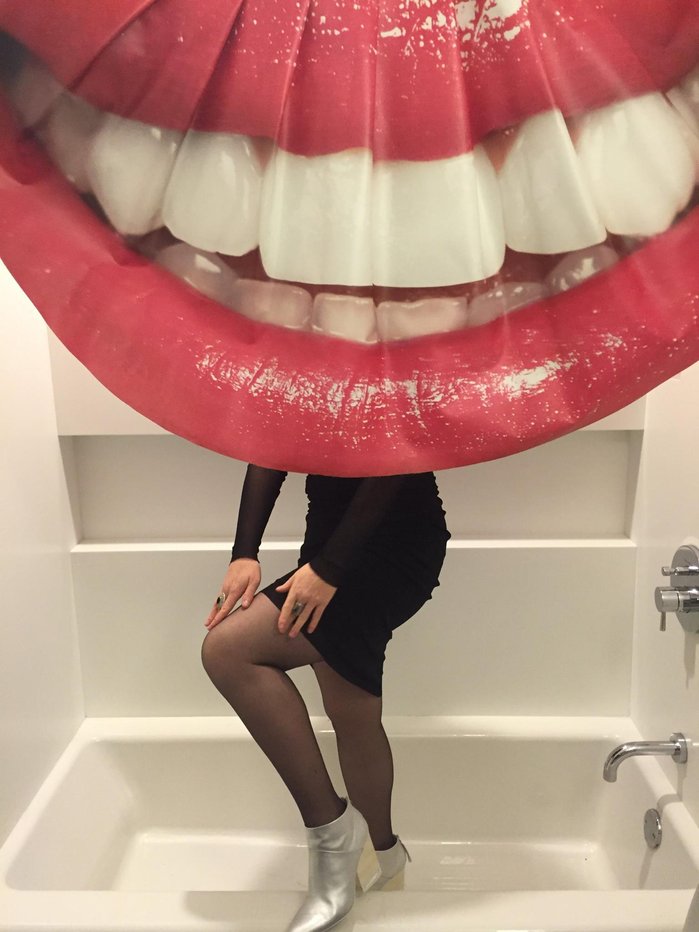
Chance Encounters, 2016, curatorial presentation on the politics of smiling with art by Lauren Ruth, bathtub of Santa Barbara Center for Art, Science and Technology
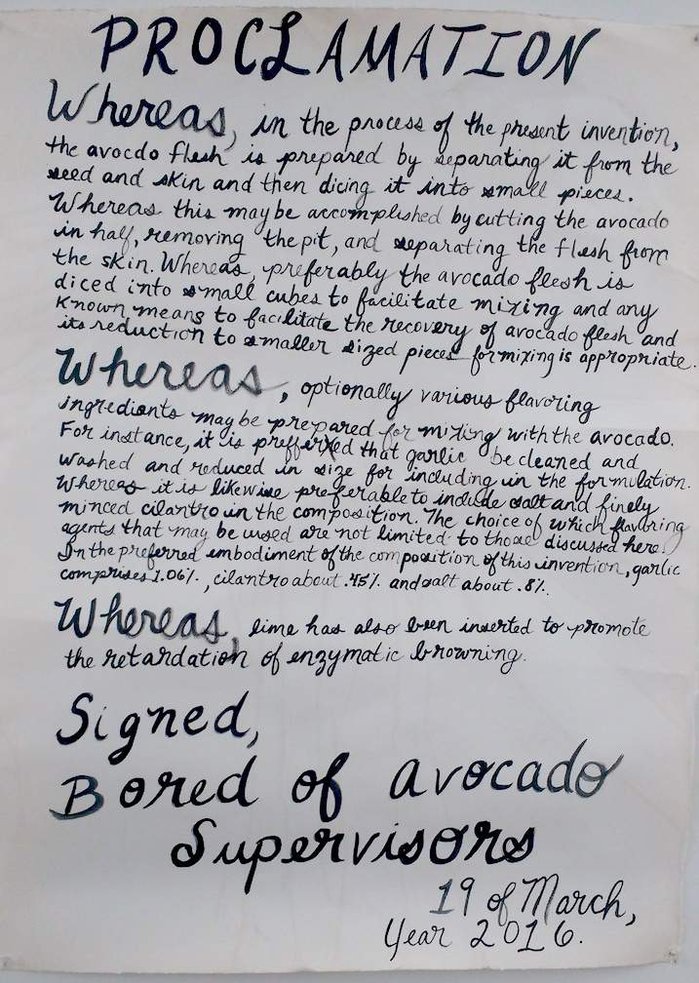
Guacamole + Proclamation = Guaclamation (written for Explain Your Food event), 2016, ink on paper, Santa Barbara Center for Art, Science and Technology

DREAM WEDDING: A SHAFT PERFORMANCE (Maiza Hixson & Lauren Ruth), Friday, June 19, 2015, 8-11 p.m., Dreamland, Louisville, KY.
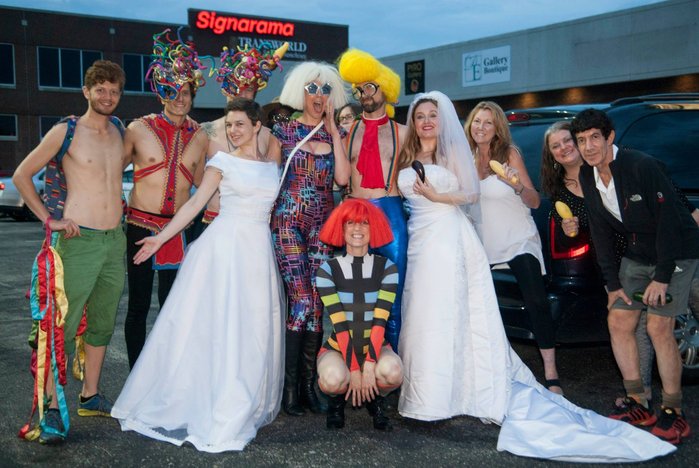
The Shaft: Dream Wedding, 2015, interactive performance with vegetables, Dreamland, Louisville, KY
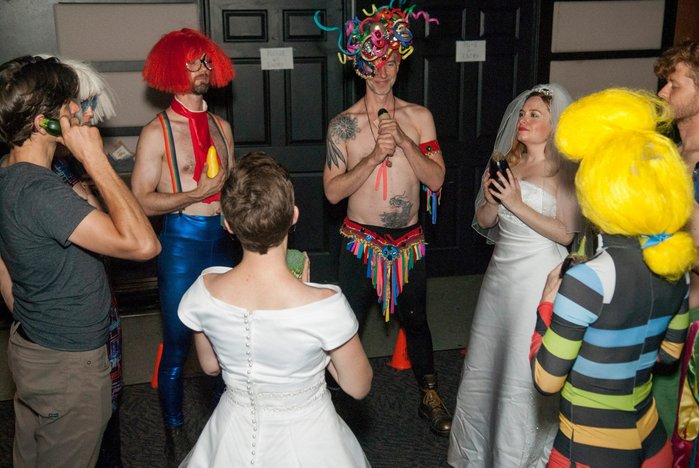
The Shaft: Organic Garden Meditation, interactive performance, 2015, Dreamland, Louisville, KY
Total Wedding Package video included in Who's Afraid of Feminism Exhibition, September 2015, A.I.R. Gallery, Brooklyn, Juried by Catherine Morris, Sackler Family Curator, Brooklyn Museum of Art
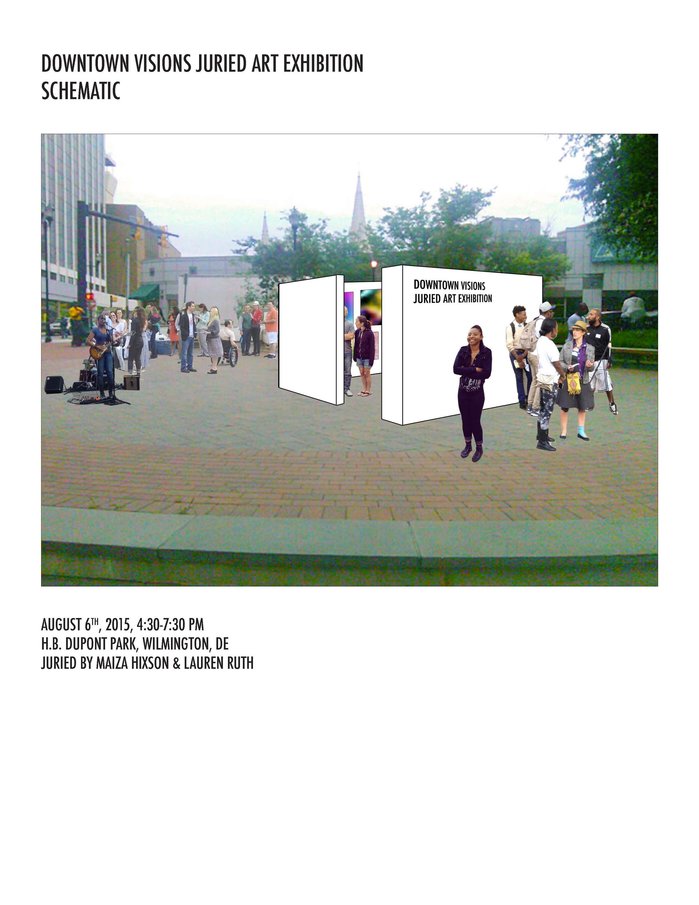
The Shaft: Juried Art Exhibition, August 2015
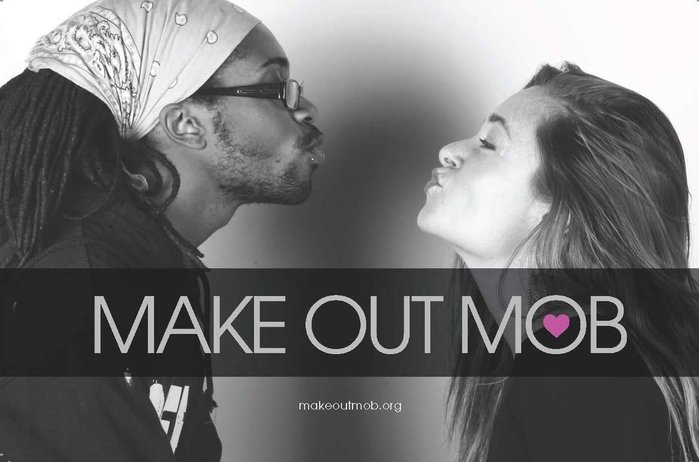
Make Out Mob, 2015, is a grassroots campaign to promote peace in downtown Wilmington.
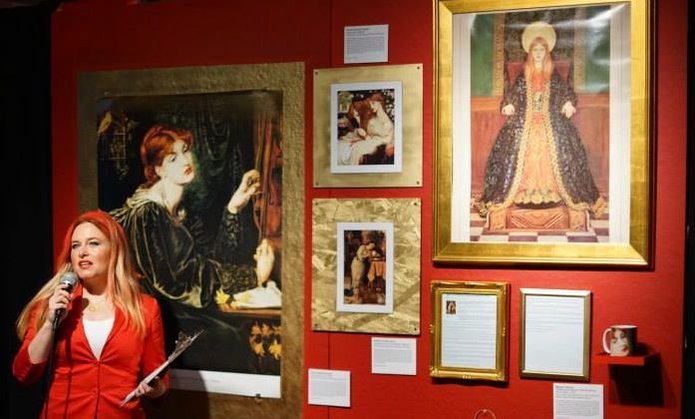
Pale Redhead Urge Surf, Little Berlin Gallery, Philadelphia, 2014. As Curator of Pale Redhead Urge Surf, I erected a red wall and hung a number of reproductions of Pre-Raphaelite paintings purchased from the Delaware Art Museum gift shop. I then spray-painted gilded frames for each poster and made wall labels detailing the history of the Pre-Raphaelites and their artistic penchant for pale redheads. I also narrated the story of the Delaware Art Museum's recent sale of the famous Pre-Raphaelite painting by William Holman Hunt entitled Isabella and the Pot of Basil (1868).
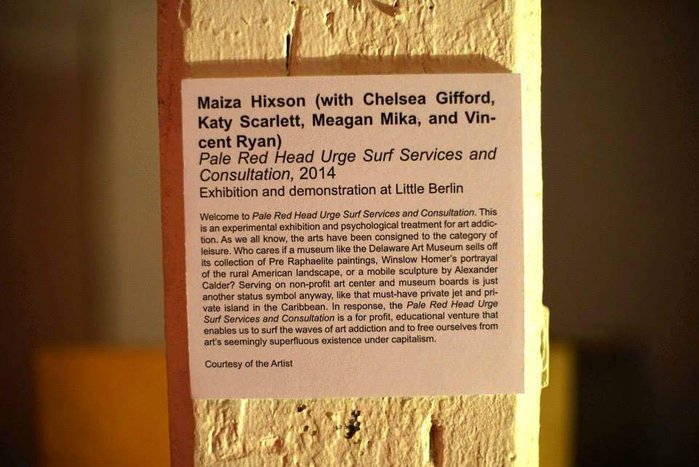
Pale Redhead Urge Surf wall label, 2014.
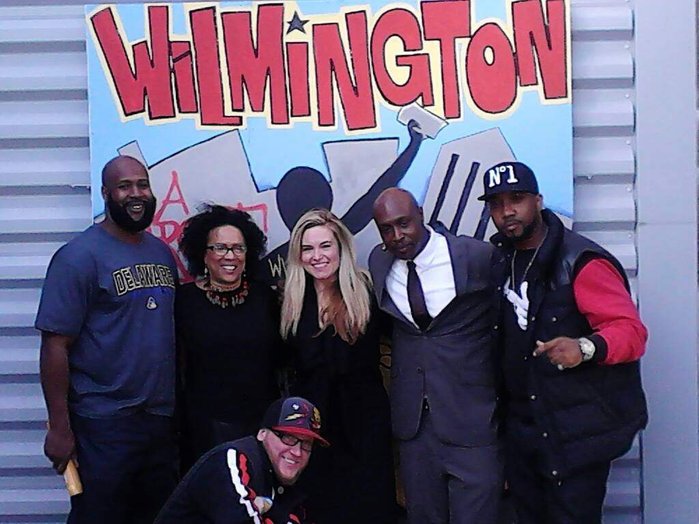
Wilmington Trap Stars: Street Art Exhibition Collaborators Dr. Yasser Payne to my right and Raye Jones Avery to my left
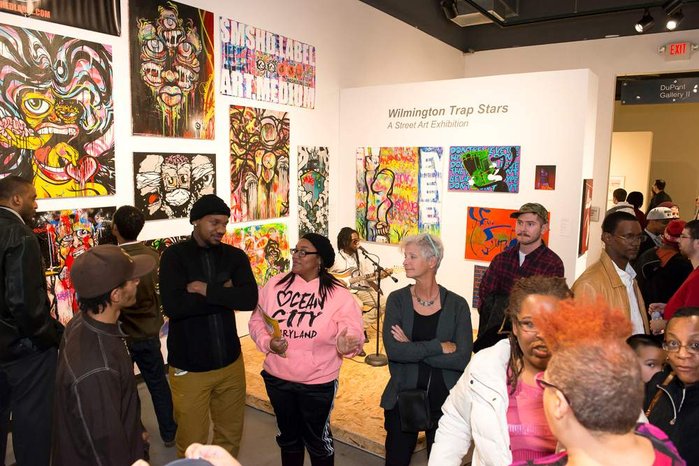
Wilmington Trap Stars, A Street Art Exhibition, co-curated with Dr. Yasser Payne, 2014, Wilmington, DE
Higher Love, 2013, Group Marriages to elevated consciousness in the Brooklyn Museum freight elevator by The Shaft (Maiza Hixson and Lauren Ruth). The Shaft was invited to perform in the elevator as part of the Institute for Psychogeographic Adventure's deconstructed museum tour for the Brooklyn Emerging Artists in Theater festival.
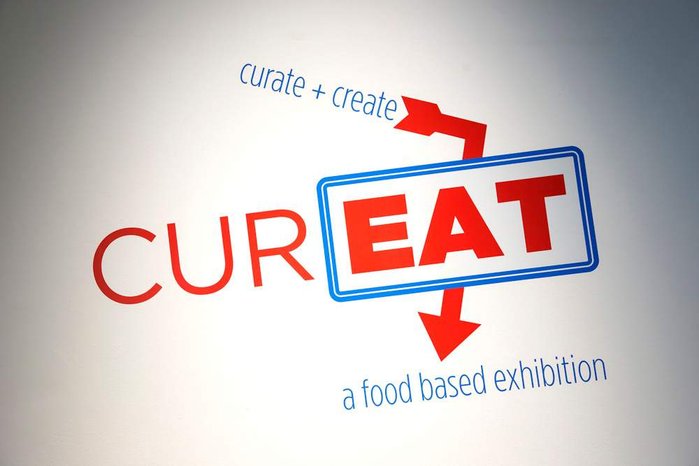
CUREAT: A Food Based Exhibition with Tom Marioni and Michael O'Malley that I organized at the Delaware Center for the Contemporary Arts, from August - November, 2013.
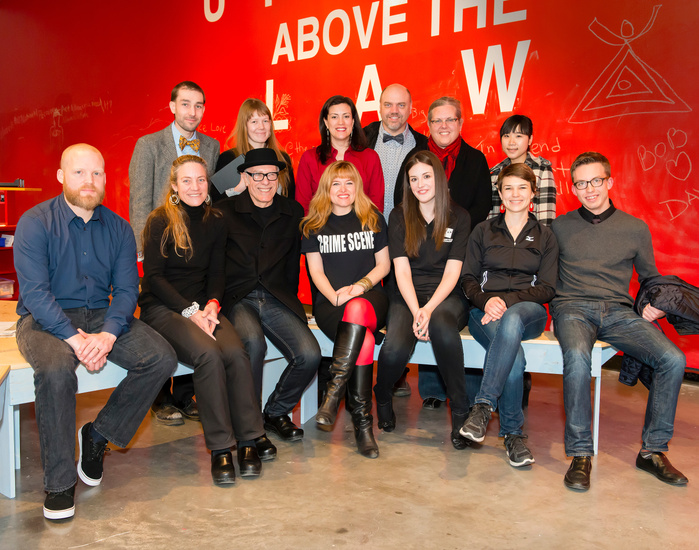
Radical Participation, a series of interactive exhibitions funded by The Andy Warhol Foundation for the Visual Arts. I curated a utopian community and exhibition at the Delaware Center for the Contemporary Arts, 2012-2013.
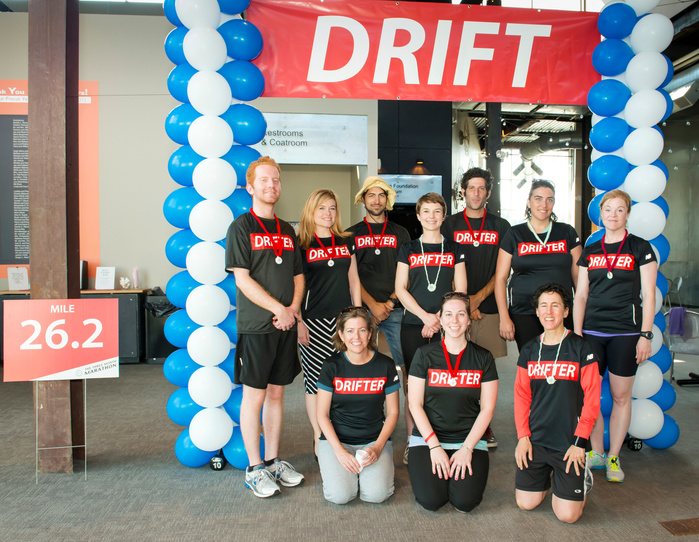


April 2012:
Sustainable Shaft: Need a LIFT?
Recycling green technologies pioneered in the 1960s, the Shaft presents Sustainable Shaft, a Bio-Powered Elevator. Just as technological developments shape the history of artistic production, art itself informs our experience of daily life. The elevator, an electric-powered pulley system, signifies an era complicit with coal-fired energy generation. As an elevator gallery, The SHAFT replaces electric power with people power, inaugurating a progressive future of energy consumption that relies upon sustaining rather than depleting our natural resources.
According to Thomas Elsaesser in his article ‘Constructive Instability,’ “As Slavoj Zizek puts it, in his review of the debate of evolutionary biology, adaptation and the birth of consciousness, human beings are constitutively un-adapted.
‘In other words, the obsolescence of art and the avant-garde may not be an inescapable conclusion to the post-human position. Yet surely any project of an avant-garde for the 21st century is obliged to reflect on the definition not only of art and life, both of which now stand under the sign of techne, but this techne needs itself to be refigured around the notion of artifice as a practice situated between design, engineering and programming: life becomes more ‘artificial’ by being understood to be both engineered and programmable, which raises an interesting prospect and may even hold out a promise: namely, the possibility that art will become more life-like (in the sense of emulating reproduction, generation, replication, mutation, chance and contingency,) in order to remain ‘art’. This is what I meant by my speculation that art and life might be about to change places, under the condition of their mutual, outside determinations.’”
Maiza Hixson and Lauren Ruth
The Shaft presents Pre-Vaporism: Movement in the Shaft, 2012
Gallery as Elevator as Work of Art
The Shaft is a young philosopher who recently graduated from one of the top MFA programs in the country (MF USA). It rose to fame in 2011 for a series of artistic and curatorial provocations that garnered a frenzy of media attention. Espousing a new theory that “Art is what is made before the aliens get us,” The Shaft’s “Pre-Vaporist Movement” has quickly become the single most popular argument made for art of the 21st Century. The Shaft defines Pre-Vaporism as the belief that since all art is going to be incinerated forever by an uncontrollable outside force anyway, then all object-based art must be futile.
The subject of a feature story in the January 2012 edition of L’Art For Homme (a men’s fine art magazine), The Shaft stated:
"Pre-Vaporism is:
-A non-objective art movement
-The past, present, and future of art
-Art before the world is obliterated
-Unauthorized
-Genderless
-Self-negating
-Humble
-Participatory
Pre-Vaporism is not:
-A dance party
-The product of a lazy artist philosopher
-For display purposes
-For sale"
Maiza Hixson
Men Are Much Harder 2, 2006-2011, interviews
Two examples of my previous projects involving audience responses in relation to contemporary art and visual culture include Men Are Much Harder 2, (2006, 2010) and It’s So What, (2010-11). The issue of creating a personal connection formed the basis for Men Are Much Harder 2 in anticipation of an exhibition that I organized in 2006 in Louisville, Kentucky entitled Oh Boy: Men and Masculinity. I was inspired by a study conducted by Beth Eck of James Madison University who researched ways in which men and women responded to images of the male and female nude in pornographic, medical and artistic contexts. Oh Boy featured photography and video by several contemporary artists who depicted men in various conditions, from bodybuilders to patients undergoing sexual reassignment surgery. One week prior to the opening of the exhibition, I invited people to the gallery where Oh Boy would be held. I showed them 11 x 17-inch reproductions of the works that would appear in Oh Boy a week later. I interviewed and videotaped the participants on their subjective reactions to the artwork. After recording the volunteers’ responses, I edited the footage and presented it as an audio-visual introduction to the show. Participants returned the following week, some with family and friends, to attend the opening and to see their own interviews.
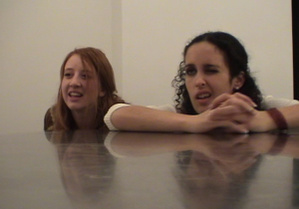
Maiza Hixson
Men Are Much Harder (Interview stills of Two Girls 1 and 2), 2006-2012
Interviews with Gallery Visitors on images of the male nude, Louisville, KY
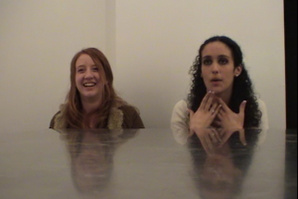
Maiza Hixson
Men Are Much Harder (Interview stills of Two Girls 1 and 2), 2006-2012
Interviews with Gallery Visitors on images of the male nude, Louisville, KY
Maiza Hixson
Curatorial Conversation/Consultation, 2011
Interactive and recorded dialogue with Vox Populi gallery visitors on images of rural life in contemporary art and culture, Philadelphia, PA
Maiza Hixson
Curatorial Conversation/Consultation (Image of Katie and Kathleen Cassidy), 2011
Interactive dialogue with Vox Populi gallery visitors
Maiza Hixson
Conversation/Consultation (Image of Anonymous participants), 2011
Interactive dialogue with Vox Populi gallery visitors
Maiza Hixson
Curatorial Conversation/Consultation (Image of assistants Caroline Beeler and Lauren Ruth and I), 2011
Interactive and recorded dialogue with Vox Populi gallery
visitors on images of rural life in contemporary art and culture, Philadelphia, PA
Maiza Hixson
It’s So What, 2010
Interviews with party guests on works of art in the home of an art collector,
Louisville, KY
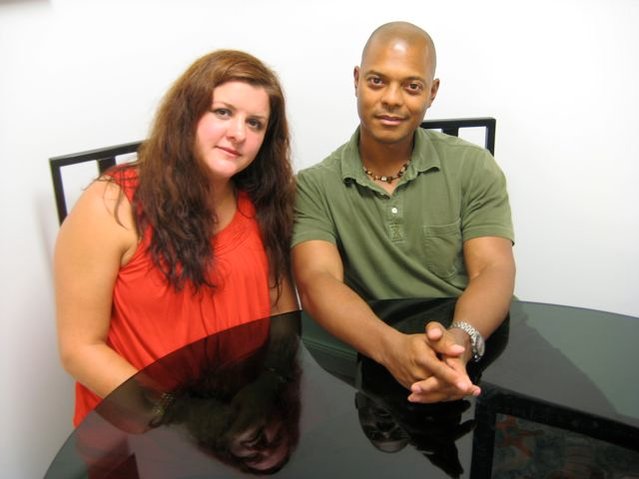
Maiza Hixson
It’s So What, 2010
Interviews with party guests on works of art in the home of an art collector,
Louisville, KY
Image of Interviewees Cynthia Norton and Jou Jou Papailler
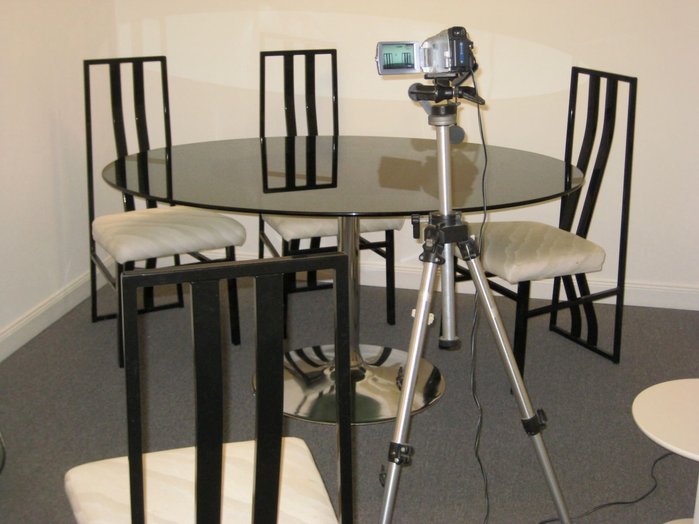
Maiza Hixson
It’s So What, 2010
Interviews with party guests on works of art in the home of an art collector,
Louisville, KY
Image of interview station in art collector's office
For It’s So What, I tested Nina Simon’s theory that people want more than to “attend” cultural events. On the occasion of a private fundraising event for the Louisville Orchestra at the home of Larry Shapin and Ladonna Nicolas, I conducted a series of interviews on the collection of contemporary art on display. Using their art collection as a conversational catalyst rather than as an innocuous backdrop to a party, I showed the guests, including artists and the collectors themselves, reproductions of selected works from the Shapin/Nicolas collection, interviewed people on their thoughts about the artwork and videotaped their responses. I edited the footage from the interviews and held a screening of the interviews at the home of the collectors one month after the event took place. Attending the screening were the collectors and several of the participants who enjoyed watching themselves and others react in a highly engaged and meaningful way to the artwork. Many guests I interviewed took offense at the collectors’ works and reacted negatively toward it. Others enjoyed the works and the collectors were pleased to see how much of an impact their art made on guests.
Maiza Hixson
CurEAT, 2011
Curate + Create = CurEAT: All exhibitions are buffets of ideas and all art is theoretically edibile
Project with Towson MFA Students in which students curated an exhibition as work of art based upon interactive food-based projects.
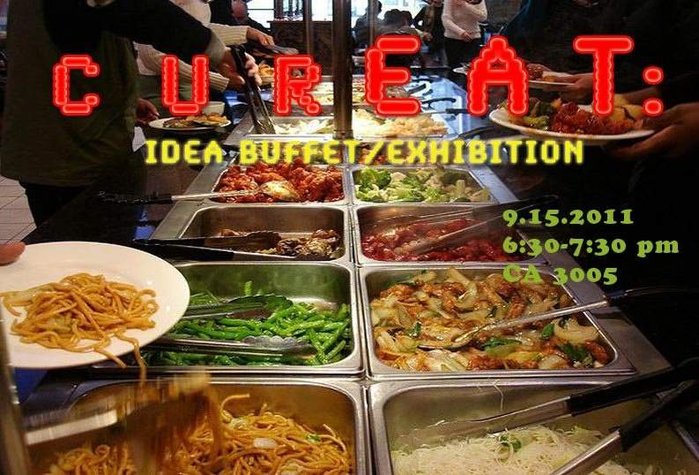
Curatorial collaboration with Towson MFA Students
CurEAT, 2011, Baltimore, MD
CURATE + CREATE =CUR(EAT)
Concept of CUR(EAT): Exhibitions Are Interactive Buffets of Ideas and All Art is Theoretically Edible
Image of Exhibition card
For this collaboration, students responded to the following prompt:
-It draws upon your particular strengths as an artist and human being.
-It is interactive w/ your imagined museum visitor/audience. Who is your audience?
-It is geared toward or related to the particular venue place or institution where the exhibition is to be held. In this case, the venue is a university classroom.
-It acknowledges particular art historical and cultural precedents.
-It critically and creatively initiates a dialogue with the premise of the show (in this case CUR(EAT).
-It favors a collective or social approach to artistic expression (i.e., it can involve multiple “artists” or “assistants” who help realize the work.
-It is both educational and pleasurable for the viewer.
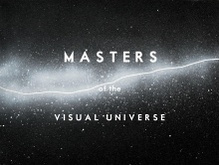
Curatorial collaboration with Towson University MFA Students: David Armacost, Jordan Bernier, Kelly Brady, Yong Jea Cho, Joseph Cypressi, Elizabeth Donadio, Peter Eide, Keith Lea, Zeke Luman, Ursula Minervini, Steven Riddle, Andrew Snyder, Rachel Timmins, and
Vincent Valerio
MFA?, 2011
Interactive new media exhibit and curatorial response to the Masters of the Visual Universe exhibition at the Delaware Center for the Contemporary Arts (DCCA), Wilmington, DE
This interactive exhibition represents the creative outcome of an intensive curatorial collaboration between the DCCA and 14 students enrolled in the MFA program at Towson University (Baltimore, MD). I asked students to respond to two ideas: what curating means to them and what obtaining an MFA represents to them. Each student produced two-minute videos responding to the prompt, MFA? Students organized this as an “exhibition as work of art,” and invite DCCA visitors to be recorded in front of a green screen as they walk into the MFA Biennial exhibition, Masters of the Visual Universe. As visitors pass by a computer camera, their recorded image is projected onto the wall and displayed inside the students’ individual videos. The result is a virtual experience for the viewer who sees him or herself reflected inside a work of art. Educational and participatory, this exhibition engages visitors on art education while interrogating the traditional curatorial practice of putting objects on display.








